Linearity engineering in permafrost areas
1
2001
... 青藏铁路是全球海拔最高和里程最长的高原高寒地区铁路,全线运营里程约1 925 km,格尔木-拉萨段约1 118 km,其中在海拔4 000 m以上约965 km.青藏铁路穿越高原多年冻土区达到632 km,包括:岛状、片状不连续多年冻土区约82 km,大区域连续多年冻土区约550 km,其中高温高含冰量多年冻土区约为355 km[1-4].青藏铁路在多年冻土区的安全运行首要解决的问题是保证高温高含冰量冻土路基的融沉变形在可控的安全范围内,相关“主动冷却路基”工程措施的目的就是确保多年冻土热稳定性,使得多年冻土上限不发生明显下移,控制冻土地温的升温速率,避免多年冻土区路基产生过大的融化沉降变形和高温冻土的蠕变沉降变形[5-9]. ...
多年冻土地区线性工程建设
1
2001
... 青藏铁路是全球海拔最高和里程最长的高原高寒地区铁路,全线运营里程约1 925 km,格尔木-拉萨段约1 118 km,其中在海拔4 000 m以上约965 km.青藏铁路穿越高原多年冻土区达到632 km,包括:岛状、片状不连续多年冻土区约82 km,大区域连续多年冻土区约550 km,其中高温高含冰量多年冻土区约为355 km[1-4].青藏铁路在多年冻土区的安全运行首要解决的问题是保证高温高含冰量冻土路基的融沉变形在可控的安全范围内,相关“主动冷却路基”工程措施的目的就是确保多年冻土热稳定性,使得多年冻土上限不发生明显下移,控制冻土地温的升温速率,避免多年冻土区路基产生过大的融化沉降变形和高温冻土的蠕变沉降变形[5-9]. ...
Design and research of the railway on Qinghai-Tibet Plateau
0
2001
A review of recent frozen soil engineering in permafrost regions along Qinghai-Tibet Highway, China
0
2002
Assessment of frozen-ground conditions for engineering geology along the Qinghai-Tibet highway and railway, China
2
2008
... 青藏铁路是全球海拔最高和里程最长的高原高寒地区铁路,全线运营里程约1 925 km,格尔木-拉萨段约1 118 km,其中在海拔4 000 m以上约965 km.青藏铁路穿越高原多年冻土区达到632 km,包括:岛状、片状不连续多年冻土区约82 km,大区域连续多年冻土区约550 km,其中高温高含冰量多年冻土区约为355 km[1-4].青藏铁路在多年冻土区的安全运行首要解决的问题是保证高温高含冰量冻土路基的融沉变形在可控的安全范围内,相关“主动冷却路基”工程措施的目的就是确保多年冻土热稳定性,使得多年冻土上限不发生明显下移,控制冻土地温的升温速率,避免多年冻土区路基产生过大的融化沉降变形和高温冻土的蠕变沉降变形[5-9]. ...
... 青藏铁路采用“主动冷却路基”思路积极保护多年冻土,利用块碎石材料、通风管、遮阳棚(板)、热棒等工程措施,通过调整和控制热对流、太阳辐射或热传导的思路,降低传入路基内部的热量,避免路基下多年冻土温度的升高[10-14].其中,通过调控热传导换热机制的块石基底路基、块石护坡路基、U型块石路基在不同的路段被大量采用,三种类型的块石路基结构在青藏铁路多年冻土区运营里程中占到了60%以上[15-17]:(1)块石基底路基结构是不同高度的路基填料层下铺设一定厚度的块石层基底;(2)块石护坡路基结构是指路基边坡铺设一定厚度的块石层护坡;(3)U型路基结构是综合上述两种路基结构,在路基填料层下铺设块石层,在边坡再铺设一定厚度的块石层护坡.块石路基主动降温的原理主要是由于块石层内存在的强制对流和自然对流,基于冬季的空气对流换热作用和夏季的隔热作用,可以有效地主动冷却块石路基下的多年冻土层[18-20].但也有研究表明,块石路基在低温冻土区的降温效果较好,而在高温多年冻土区降温效果不太理想[21-23].此外,青藏高原多年冻土区对近年来全球气候变暖的响应极其敏感,青藏高原冻土工程走廊内线性工程的修筑和运营,又进一步叠加了人类活动对多年冻土地区温度场的影响,并引起了广大多年冻土区的渐进退化,威胁到多年冻土区内的青藏铁路路基热稳定,尤其是位于高温、富冰区的路基地段[4,24-28].到目前为止,多年冻土区内的青藏铁路已建成并安全运行了16年以上.在长期的运营过程中,多年冻土区内未采取冷却措施的某些普通路基路段,已出现路基下多年冻土加速退化的趋势,特别是在高温及富冰的多年冻土区[29-31].对普通路基的维修补强措施主要以块石护坡、护道为主,并在个别地段增设了热棒,对路基下的多年冻土取得了一定的主动降温效果[32-34].在青藏铁路穿越的个别沙漠化较为严重的多年冻土区段,风积沙堵塞了块石路基的孔隙,降低了块石结构的孔隙率,影响了块石结构调节多年冻土温度的能力[35-37].此前已有大量文献通过现场监测资料,分析了不同路基结构的热状况[9,12,14,21-23],但这些研究大多基于短期的现场监测数据,长期运营后路基热稳定状态的相关研究仍然较少,考虑到高温冻土区内的多年冻土对温度变化的敏感性更高,因此,对于青藏铁路高温多年冻土区内的不同路基结构,其在长周期条件下的多年冻土路基热稳定性是迫切值得关注的问题. ...
Construction of Qinghai-Tibet railway with cooled roadbed
1
2003
... 青藏铁路是全球海拔最高和里程最长的高原高寒地区铁路,全线运营里程约1 925 km,格尔木-拉萨段约1 118 km,其中在海拔4 000 m以上约965 km.青藏铁路穿越高原多年冻土区达到632 km,包括:岛状、片状不连续多年冻土区约82 km,大区域连续多年冻土区约550 km,其中高温高含冰量多年冻土区约为355 km[1-4].青藏铁路在多年冻土区的安全运行首要解决的问题是保证高温高含冰量冻土路基的融沉变形在可控的安全范围内,相关“主动冷却路基”工程措施的目的就是确保多年冻土热稳定性,使得多年冻土上限不发生明显下移,控制冻土地温的升温速率,避免多年冻土区路基产生过大的融化沉降变形和高温冻土的蠕变沉降变形[5-9]. ...
用冷却路基的方法修建青藏铁路
1
2003
... 青藏铁路是全球海拔最高和里程最长的高原高寒地区铁路,全线运营里程约1 925 km,格尔木-拉萨段约1 118 km,其中在海拔4 000 m以上约965 km.青藏铁路穿越高原多年冻土区达到632 km,包括:岛状、片状不连续多年冻土区约82 km,大区域连续多年冻土区约550 km,其中高温高含冰量多年冻土区约为355 km[1-4].青藏铁路在多年冻土区的安全运行首要解决的问题是保证高温高含冰量冻土路基的融沉变形在可控的安全范围内,相关“主动冷却路基”工程措施的目的就是确保多年冻土热稳定性,使得多年冻土上限不发生明显下移,控制冻土地温的升温速率,避免多年冻土区路基产生过大的融化沉降变形和高温冻土的蠕变沉降变形[5-9]. ...
Study and application of idea of dynamic design in Qinghai-Tibet Railway construction
0
2004
青藏铁路建设中动态设计思路及其应用研究
0
2004
Study on thaw consolidation of permafrost under roadway embankment
0
2012
Adaptation methods for transportation infrastructure built on degrading permafrost
0
2016
Thermal characteristics and declining permafrost table beneath three cooling embankments in warm permafrost regions
2
2017
... 青藏铁路是全球海拔最高和里程最长的高原高寒地区铁路,全线运营里程约1 925 km,格尔木-拉萨段约1 118 km,其中在海拔4 000 m以上约965 km.青藏铁路穿越高原多年冻土区达到632 km,包括:岛状、片状不连续多年冻土区约82 km,大区域连续多年冻土区约550 km,其中高温高含冰量多年冻土区约为355 km[1-4].青藏铁路在多年冻土区的安全运行首要解决的问题是保证高温高含冰量冻土路基的融沉变形在可控的安全范围内,相关“主动冷却路基”工程措施的目的就是确保多年冻土热稳定性,使得多年冻土上限不发生明显下移,控制冻土地温的升温速率,避免多年冻土区路基产生过大的融化沉降变形和高温冻土的蠕变沉降变形[5-9]. ...
... 青藏铁路采用“主动冷却路基”思路积极保护多年冻土,利用块碎石材料、通风管、遮阳棚(板)、热棒等工程措施,通过调整和控制热对流、太阳辐射或热传导的思路,降低传入路基内部的热量,避免路基下多年冻土温度的升高[10-14].其中,通过调控热传导换热机制的块石基底路基、块石护坡路基、U型块石路基在不同的路段被大量采用,三种类型的块石路基结构在青藏铁路多年冻土区运营里程中占到了60%以上[15-17]:(1)块石基底路基结构是不同高度的路基填料层下铺设一定厚度的块石层基底;(2)块石护坡路基结构是指路基边坡铺设一定厚度的块石层护坡;(3)U型路基结构是综合上述两种路基结构,在路基填料层下铺设块石层,在边坡再铺设一定厚度的块石层护坡.块石路基主动降温的原理主要是由于块石层内存在的强制对流和自然对流,基于冬季的空气对流换热作用和夏季的隔热作用,可以有效地主动冷却块石路基下的多年冻土层[18-20].但也有研究表明,块石路基在低温冻土区的降温效果较好,而在高温多年冻土区降温效果不太理想[21-23].此外,青藏高原多年冻土区对近年来全球气候变暖的响应极其敏感,青藏高原冻土工程走廊内线性工程的修筑和运营,又进一步叠加了人类活动对多年冻土地区温度场的影响,并引起了广大多年冻土区的渐进退化,威胁到多年冻土区内的青藏铁路路基热稳定,尤其是位于高温、富冰区的路基地段[4,24-28].到目前为止,多年冻土区内的青藏铁路已建成并安全运行了16年以上.在长期的运营过程中,多年冻土区内未采取冷却措施的某些普通路基路段,已出现路基下多年冻土加速退化的趋势,特别是在高温及富冰的多年冻土区[29-31].对普通路基的维修补强措施主要以块石护坡、护道为主,并在个别地段增设了热棒,对路基下的多年冻土取得了一定的主动降温效果[32-34].在青藏铁路穿越的个别沙漠化较为严重的多年冻土区段,风积沙堵塞了块石路基的孔隙,降低了块石结构的孔隙率,影响了块石结构调节多年冻土温度的能力[35-37].此前已有大量文献通过现场监测资料,分析了不同路基结构的热状况[9,12,14,21-23],但这些研究大多基于短期的现场监测数据,长期运营后路基热稳定状态的相关研究仍然较少,考虑到高温冻土区内的多年冻土对温度变化的敏感性更高,因此,对于青藏铁路高温多年冻土区内的不同路基结构,其在长周期条件下的多年冻土路基热稳定性是迫切值得关注的问题. ...
Innovative designs of permafrost roadbed for the Qinghai-Tibet Railway
1
2009
... 青藏铁路采用“主动冷却路基”思路积极保护多年冻土,利用块碎石材料、通风管、遮阳棚(板)、热棒等工程措施,通过调整和控制热对流、太阳辐射或热传导的思路,降低传入路基内部的热量,避免路基下多年冻土温度的升高[10-14].其中,通过调控热传导换热机制的块石基底路基、块石护坡路基、U型块石路基在不同的路段被大量采用,三种类型的块石路基结构在青藏铁路多年冻土区运营里程中占到了60%以上[15-17]:(1)块石基底路基结构是不同高度的路基填料层下铺设一定厚度的块石层基底;(2)块石护坡路基结构是指路基边坡铺设一定厚度的块石层护坡;(3)U型路基结构是综合上述两种路基结构,在路基填料层下铺设块石层,在边坡再铺设一定厚度的块石层护坡.块石路基主动降温的原理主要是由于块石层内存在的强制对流和自然对流,基于冬季的空气对流换热作用和夏季的隔热作用,可以有效地主动冷却块石路基下的多年冻土层[18-20].但也有研究表明,块石路基在低温冻土区的降温效果较好,而在高温多年冻土区降温效果不太理想[21-23].此外,青藏高原多年冻土区对近年来全球气候变暖的响应极其敏感,青藏高原冻土工程走廊内线性工程的修筑和运营,又进一步叠加了人类活动对多年冻土地区温度场的影响,并引起了广大多年冻土区的渐进退化,威胁到多年冻土区内的青藏铁路路基热稳定,尤其是位于高温、富冰区的路基地段[4,24-28].到目前为止,多年冻土区内的青藏铁路已建成并安全运行了16年以上.在长期的运营过程中,多年冻土区内未采取冷却措施的某些普通路基路段,已出现路基下多年冻土加速退化的趋势,特别是在高温及富冰的多年冻土区[29-31].对普通路基的维修补强措施主要以块石护坡、护道为主,并在个别地段增设了热棒,对路基下的多年冻土取得了一定的主动降温效果[32-34].在青藏铁路穿越的个别沙漠化较为严重的多年冻土区段,风积沙堵塞了块石路基的孔隙,降低了块石结构的孔隙率,影响了块石结构调节多年冻土温度的能力[35-37].此前已有大量文献通过现场监测资料,分析了不同路基结构的热状况[9,12,14,21-23],但这些研究大多基于短期的现场监测数据,长期运营后路基热稳定状态的相关研究仍然较少,考虑到高温冻土区内的多年冻土对温度变化的敏感性更高,因此,对于青藏铁路高温多年冻土区内的不同路基结构,其在长周期条件下的多年冻土路基热稳定性是迫切值得关注的问题. ...
青藏铁路主动冷却路基的工程效果
1
2009
... 青藏铁路采用“主动冷却路基”思路积极保护多年冻土,利用块碎石材料、通风管、遮阳棚(板)、热棒等工程措施,通过调整和控制热对流、太阳辐射或热传导的思路,降低传入路基内部的热量,避免路基下多年冻土温度的升高[10-14].其中,通过调控热传导换热机制的块石基底路基、块石护坡路基、U型块石路基在不同的路段被大量采用,三种类型的块石路基结构在青藏铁路多年冻土区运营里程中占到了60%以上[15-17]:(1)块石基底路基结构是不同高度的路基填料层下铺设一定厚度的块石层基底;(2)块石护坡路基结构是指路基边坡铺设一定厚度的块石层护坡;(3)U型路基结构是综合上述两种路基结构,在路基填料层下铺设块石层,在边坡再铺设一定厚度的块石层护坡.块石路基主动降温的原理主要是由于块石层内存在的强制对流和自然对流,基于冬季的空气对流换热作用和夏季的隔热作用,可以有效地主动冷却块石路基下的多年冻土层[18-20].但也有研究表明,块石路基在低温冻土区的降温效果较好,而在高温多年冻土区降温效果不太理想[21-23].此外,青藏高原多年冻土区对近年来全球气候变暖的响应极其敏感,青藏高原冻土工程走廊内线性工程的修筑和运营,又进一步叠加了人类活动对多年冻土地区温度场的影响,并引起了广大多年冻土区的渐进退化,威胁到多年冻土区内的青藏铁路路基热稳定,尤其是位于高温、富冰区的路基地段[4,24-28].到目前为止,多年冻土区内的青藏铁路已建成并安全运行了16年以上.在长期的运营过程中,多年冻土区内未采取冷却措施的某些普通路基路段,已出现路基下多年冻土加速退化的趋势,特别是在高温及富冰的多年冻土区[29-31].对普通路基的维修补强措施主要以块石护坡、护道为主,并在个别地段增设了热棒,对路基下的多年冻土取得了一定的主动降温效果[32-34].在青藏铁路穿越的个别沙漠化较为严重的多年冻土区段,风积沙堵塞了块石路基的孔隙,降低了块石结构的孔隙率,影响了块石结构调节多年冻土温度的能力[35-37].此前已有大量文献通过现场监测资料,分析了不同路基结构的热状况[9,12,14,21-23],但这些研究大多基于短期的现场监测数据,长期运营后路基热稳定状态的相关研究仍然较少,考虑到高温冻土区内的多年冻土对温度变化的敏感性更高,因此,对于青藏铁路高温多年冻土区内的不同路基结构,其在长周期条件下的多年冻土路基热稳定性是迫切值得关注的问题. ...
Construction on permafrost foundations: lessons learned from the Qinghai-Tibet railroad
0
2009
Investigation of embankment with temperature-controlled ventilation along the Qinghai-Tibet Railway
1
2008
... 青藏铁路采用“主动冷却路基”思路积极保护多年冻土,利用块碎石材料、通风管、遮阳棚(板)、热棒等工程措施,通过调整和控制热对流、太阳辐射或热传导的思路,降低传入路基内部的热量,避免路基下多年冻土温度的升高[10-14].其中,通过调控热传导换热机制的块石基底路基、块石护坡路基、U型块石路基在不同的路段被大量采用,三种类型的块石路基结构在青藏铁路多年冻土区运营里程中占到了60%以上[15-17]:(1)块石基底路基结构是不同高度的路基填料层下铺设一定厚度的块石层基底;(2)块石护坡路基结构是指路基边坡铺设一定厚度的块石层护坡;(3)U型路基结构是综合上述两种路基结构,在路基填料层下铺设块石层,在边坡再铺设一定厚度的块石层护坡.块石路基主动降温的原理主要是由于块石层内存在的强制对流和自然对流,基于冬季的空气对流换热作用和夏季的隔热作用,可以有效地主动冷却块石路基下的多年冻土层[18-20].但也有研究表明,块石路基在低温冻土区的降温效果较好,而在高温多年冻土区降温效果不太理想[21-23].此外,青藏高原多年冻土区对近年来全球气候变暖的响应极其敏感,青藏高原冻土工程走廊内线性工程的修筑和运营,又进一步叠加了人类活动对多年冻土地区温度场的影响,并引起了广大多年冻土区的渐进退化,威胁到多年冻土区内的青藏铁路路基热稳定,尤其是位于高温、富冰区的路基地段[4,24-28].到目前为止,多年冻土区内的青藏铁路已建成并安全运行了16年以上.在长期的运营过程中,多年冻土区内未采取冷却措施的某些普通路基路段,已出现路基下多年冻土加速退化的趋势,特别是在高温及富冰的多年冻土区[29-31].对普通路基的维修补强措施主要以块石护坡、护道为主,并在个别地段增设了热棒,对路基下的多年冻土取得了一定的主动降温效果[32-34].在青藏铁路穿越的个别沙漠化较为严重的多年冻土区段,风积沙堵塞了块石路基的孔隙,降低了块石结构的孔隙率,影响了块石结构调节多年冻土温度的能力[35-37].此前已有大量文献通过现场监测资料,分析了不同路基结构的热状况[9,12,14,21-23],但这些研究大多基于短期的现场监测数据,长期运营后路基热稳定状态的相关研究仍然较少,考虑到高温冻土区内的多年冻土对温度变化的敏感性更高,因此,对于青藏铁路高温多年冻土区内的不同路基结构,其在长周期条件下的多年冻土路基热稳定性是迫切值得关注的问题. ...
Laboratory investigation of the heat transfer characteristics of a two-phase closed thermosyphon
0
2013
Field experimental study on long-term cooling performance of Sun-shaded embankments at the Qinghai-Tibet Railway, China
2
2018
... 青藏铁路采用“主动冷却路基”思路积极保护多年冻土,利用块碎石材料、通风管、遮阳棚(板)、热棒等工程措施,通过调整和控制热对流、太阳辐射或热传导的思路,降低传入路基内部的热量,避免路基下多年冻土温度的升高[10-14].其中,通过调控热传导换热机制的块石基底路基、块石护坡路基、U型块石路基在不同的路段被大量采用,三种类型的块石路基结构在青藏铁路多年冻土区运营里程中占到了60%以上[15-17]:(1)块石基底路基结构是不同高度的路基填料层下铺设一定厚度的块石层基底;(2)块石护坡路基结构是指路基边坡铺设一定厚度的块石层护坡;(3)U型路基结构是综合上述两种路基结构,在路基填料层下铺设块石层,在边坡再铺设一定厚度的块石层护坡.块石路基主动降温的原理主要是由于块石层内存在的强制对流和自然对流,基于冬季的空气对流换热作用和夏季的隔热作用,可以有效地主动冷却块石路基下的多年冻土层[18-20].但也有研究表明,块石路基在低温冻土区的降温效果较好,而在高温多年冻土区降温效果不太理想[21-23].此外,青藏高原多年冻土区对近年来全球气候变暖的响应极其敏感,青藏高原冻土工程走廊内线性工程的修筑和运营,又进一步叠加了人类活动对多年冻土地区温度场的影响,并引起了广大多年冻土区的渐进退化,威胁到多年冻土区内的青藏铁路路基热稳定,尤其是位于高温、富冰区的路基地段[4,24-28].到目前为止,多年冻土区内的青藏铁路已建成并安全运行了16年以上.在长期的运营过程中,多年冻土区内未采取冷却措施的某些普通路基路段,已出现路基下多年冻土加速退化的趋势,特别是在高温及富冰的多年冻土区[29-31].对普通路基的维修补强措施主要以块石护坡、护道为主,并在个别地段增设了热棒,对路基下的多年冻土取得了一定的主动降温效果[32-34].在青藏铁路穿越的个别沙漠化较为严重的多年冻土区段,风积沙堵塞了块石路基的孔隙,降低了块石结构的孔隙率,影响了块石结构调节多年冻土温度的能力[35-37].此前已有大量文献通过现场监测资料,分析了不同路基结构的热状况[9,12,14,21-23],但这些研究大多基于短期的现场监测数据,长期运营后路基热稳定状态的相关研究仍然较少,考虑到高温冻土区内的多年冻土对温度变化的敏感性更高,因此,对于青藏铁路高温多年冻土区内的不同路基结构,其在长周期条件下的多年冻土路基热稳定性是迫切值得关注的问题. ...
... ,14,21-23],但这些研究大多基于短期的现场监测数据,长期运营后路基热稳定状态的相关研究仍然较少,考虑到高温冻土区内的多年冻土对温度变化的敏感性更高,因此,对于青藏铁路高温多年冻土区内的不同路基结构,其在长周期条件下的多年冻土路基热稳定性是迫切值得关注的问题. ...
Monitoring and analysis of cooling effect of block-stone embankment for Qinghai-Tibet Railway
1
2005
... 青藏铁路采用“主动冷却路基”思路积极保护多年冻土,利用块碎石材料、通风管、遮阳棚(板)、热棒等工程措施,通过调整和控制热对流、太阳辐射或热传导的思路,降低传入路基内部的热量,避免路基下多年冻土温度的升高[10-14].其中,通过调控热传导换热机制的块石基底路基、块石护坡路基、U型块石路基在不同的路段被大量采用,三种类型的块石路基结构在青藏铁路多年冻土区运营里程中占到了60%以上[15-17]:(1)块石基底路基结构是不同高度的路基填料层下铺设一定厚度的块石层基底;(2)块石护坡路基结构是指路基边坡铺设一定厚度的块石层护坡;(3)U型路基结构是综合上述两种路基结构,在路基填料层下铺设块石层,在边坡再铺设一定厚度的块石层护坡.块石路基主动降温的原理主要是由于块石层内存在的强制对流和自然对流,基于冬季的空气对流换热作用和夏季的隔热作用,可以有效地主动冷却块石路基下的多年冻土层[18-20].但也有研究表明,块石路基在低温冻土区的降温效果较好,而在高温多年冻土区降温效果不太理想[21-23].此外,青藏高原多年冻土区对近年来全球气候变暖的响应极其敏感,青藏高原冻土工程走廊内线性工程的修筑和运营,又进一步叠加了人类活动对多年冻土地区温度场的影响,并引起了广大多年冻土区的渐进退化,威胁到多年冻土区内的青藏铁路路基热稳定,尤其是位于高温、富冰区的路基地段[4,24-28].到目前为止,多年冻土区内的青藏铁路已建成并安全运行了16年以上.在长期的运营过程中,多年冻土区内未采取冷却措施的某些普通路基路段,已出现路基下多年冻土加速退化的趋势,特别是在高温及富冰的多年冻土区[29-31].对普通路基的维修补强措施主要以块石护坡、护道为主,并在个别地段增设了热棒,对路基下的多年冻土取得了一定的主动降温效果[32-34].在青藏铁路穿越的个别沙漠化较为严重的多年冻土区段,风积沙堵塞了块石路基的孔隙,降低了块石结构的孔隙率,影响了块石结构调节多年冻土温度的能力[35-37].此前已有大量文献通过现场监测资料,分析了不同路基结构的热状况[9,12,14,21-23],但这些研究大多基于短期的现场监测数据,长期运营后路基热稳定状态的相关研究仍然较少,考虑到高温冻土区内的多年冻土对温度变化的敏感性更高,因此,对于青藏铁路高温多年冻土区内的不同路基结构,其在长周期条件下的多年冻土路基热稳定性是迫切值得关注的问题. ...
青藏铁路块石路基结构的冷却效果监测分析
1
2005
... 青藏铁路采用“主动冷却路基”思路积极保护多年冻土,利用块碎石材料、通风管、遮阳棚(板)、热棒等工程措施,通过调整和控制热对流、太阳辐射或热传导的思路,降低传入路基内部的热量,避免路基下多年冻土温度的升高[10-14].其中,通过调控热传导换热机制的块石基底路基、块石护坡路基、U型块石路基在不同的路段被大量采用,三种类型的块石路基结构在青藏铁路多年冻土区运营里程中占到了60%以上[15-17]:(1)块石基底路基结构是不同高度的路基填料层下铺设一定厚度的块石层基底;(2)块石护坡路基结构是指路基边坡铺设一定厚度的块石层护坡;(3)U型路基结构是综合上述两种路基结构,在路基填料层下铺设块石层,在边坡再铺设一定厚度的块石层护坡.块石路基主动降温的原理主要是由于块石层内存在的强制对流和自然对流,基于冬季的空气对流换热作用和夏季的隔热作用,可以有效地主动冷却块石路基下的多年冻土层[18-20].但也有研究表明,块石路基在低温冻土区的降温效果较好,而在高温多年冻土区降温效果不太理想[21-23].此外,青藏高原多年冻土区对近年来全球气候变暖的响应极其敏感,青藏高原冻土工程走廊内线性工程的修筑和运营,又进一步叠加了人类活动对多年冻土地区温度场的影响,并引起了广大多年冻土区的渐进退化,威胁到多年冻土区内的青藏铁路路基热稳定,尤其是位于高温、富冰区的路基地段[4,24-28].到目前为止,多年冻土区内的青藏铁路已建成并安全运行了16年以上.在长期的运营过程中,多年冻土区内未采取冷却措施的某些普通路基路段,已出现路基下多年冻土加速退化的趋势,特别是在高温及富冰的多年冻土区[29-31].对普通路基的维修补强措施主要以块石护坡、护道为主,并在个别地段增设了热棒,对路基下的多年冻土取得了一定的主动降温效果[32-34].在青藏铁路穿越的个别沙漠化较为严重的多年冻土区段,风积沙堵塞了块石路基的孔隙,降低了块石结构的孔隙率,影响了块石结构调节多年冻土温度的能力[35-37].此前已有大量文献通过现场监测资料,分析了不同路基结构的热状况[9,12,14,21-23],但这些研究大多基于短期的现场监测数据,长期运营后路基热稳定状态的相关研究仍然较少,考虑到高温冻土区内的多年冻土对温度变化的敏感性更高,因此,对于青藏铁路高温多年冻土区内的不同路基结构,其在长周期条件下的多年冻土路基热稳定性是迫切值得关注的问题. ...
Application of the roadbed cooling approach in Qinghai-Tibet Railway engineering
0
2008
Cooling processes and effects of crushed rock embankment along the Qinghai-Tibet Railway in permafrost regions
1
2012
... 青藏铁路采用“主动冷却路基”思路积极保护多年冻土,利用块碎石材料、通风管、遮阳棚(板)、热棒等工程措施,通过调整和控制热对流、太阳辐射或热传导的思路,降低传入路基内部的热量,避免路基下多年冻土温度的升高[10-14].其中,通过调控热传导换热机制的块石基底路基、块石护坡路基、U型块石路基在不同的路段被大量采用,三种类型的块石路基结构在青藏铁路多年冻土区运营里程中占到了60%以上[15-17]:(1)块石基底路基结构是不同高度的路基填料层下铺设一定厚度的块石层基底;(2)块石护坡路基结构是指路基边坡铺设一定厚度的块石层护坡;(3)U型路基结构是综合上述两种路基结构,在路基填料层下铺设块石层,在边坡再铺设一定厚度的块石层护坡.块石路基主动降温的原理主要是由于块石层内存在的强制对流和自然对流,基于冬季的空气对流换热作用和夏季的隔热作用,可以有效地主动冷却块石路基下的多年冻土层[18-20].但也有研究表明,块石路基在低温冻土区的降温效果较好,而在高温多年冻土区降温效果不太理想[21-23].此外,青藏高原多年冻土区对近年来全球气候变暖的响应极其敏感,青藏高原冻土工程走廊内线性工程的修筑和运营,又进一步叠加了人类活动对多年冻土地区温度场的影响,并引起了广大多年冻土区的渐进退化,威胁到多年冻土区内的青藏铁路路基热稳定,尤其是位于高温、富冰区的路基地段[4,24-28].到目前为止,多年冻土区内的青藏铁路已建成并安全运行了16年以上.在长期的运营过程中,多年冻土区内未采取冷却措施的某些普通路基路段,已出现路基下多年冻土加速退化的趋势,特别是在高温及富冰的多年冻土区[29-31].对普通路基的维修补强措施主要以块石护坡、护道为主,并在个别地段增设了热棒,对路基下的多年冻土取得了一定的主动降温效果[32-34].在青藏铁路穿越的个别沙漠化较为严重的多年冻土区段,风积沙堵塞了块石路基的孔隙,降低了块石结构的孔隙率,影响了块石结构调节多年冻土温度的能力[35-37].此前已有大量文献通过现场监测资料,分析了不同路基结构的热状况[9,12,14,21-23],但这些研究大多基于短期的现场监测数据,长期运营后路基热稳定状态的相关研究仍然较少,考虑到高温冻土区内的多年冻土对温度变化的敏感性更高,因此,对于青藏铁路高温多年冻土区内的不同路基结构,其在长周期条件下的多年冻土路基热稳定性是迫切值得关注的问题. ...
1
2007
... 青藏铁路采用“主动冷却路基”思路积极保护多年冻土,利用块碎石材料、通风管、遮阳棚(板)、热棒等工程措施,通过调整和控制热对流、太阳辐射或热传导的思路,降低传入路基内部的热量,避免路基下多年冻土温度的升高[10-14].其中,通过调控热传导换热机制的块石基底路基、块石护坡路基、U型块石路基在不同的路段被大量采用,三种类型的块石路基结构在青藏铁路多年冻土区运营里程中占到了60%以上[15-17]:(1)块石基底路基结构是不同高度的路基填料层下铺设一定厚度的块石层基底;(2)块石护坡路基结构是指路基边坡铺设一定厚度的块石层护坡;(3)U型路基结构是综合上述两种路基结构,在路基填料层下铺设块石层,在边坡再铺设一定厚度的块石层护坡.块石路基主动降温的原理主要是由于块石层内存在的强制对流和自然对流,基于冬季的空气对流换热作用和夏季的隔热作用,可以有效地主动冷却块石路基下的多年冻土层[18-20].但也有研究表明,块石路基在低温冻土区的降温效果较好,而在高温多年冻土区降温效果不太理想[21-23].此外,青藏高原多年冻土区对近年来全球气候变暖的响应极其敏感,青藏高原冻土工程走廊内线性工程的修筑和运营,又进一步叠加了人类活动对多年冻土地区温度场的影响,并引起了广大多年冻土区的渐进退化,威胁到多年冻土区内的青藏铁路路基热稳定,尤其是位于高温、富冰区的路基地段[4,24-28].到目前为止,多年冻土区内的青藏铁路已建成并安全运行了16年以上.在长期的运营过程中,多年冻土区内未采取冷却措施的某些普通路基路段,已出现路基下多年冻土加速退化的趋势,特别是在高温及富冰的多年冻土区[29-31].对普通路基的维修补强措施主要以块石护坡、护道为主,并在个别地段增设了热棒,对路基下的多年冻土取得了一定的主动降温效果[32-34].在青藏铁路穿越的个别沙漠化较为严重的多年冻土区段,风积沙堵塞了块石路基的孔隙,降低了块石结构的孔隙率,影响了块石结构调节多年冻土温度的能力[35-37].此前已有大量文献通过现场监测资料,分析了不同路基结构的热状况[9,12,14,21-23],但这些研究大多基于短期的现场监测数据,长期运营后路基热稳定状态的相关研究仍然较少,考虑到高温冻土区内的多年冻土对温度变化的敏感性更高,因此,对于青藏铁路高温多年冻土区内的不同路基结构,其在长周期条件下的多年冻土路基热稳定性是迫切值得关注的问题. ...
The ‘thermal semi-conductor’ effect of crushed rocks
0
2007
Analyses of temperature fields under the embankment with crushed-rock structures along the Qinghai-Tibet Railway
1
2008
... 青藏铁路采用“主动冷却路基”思路积极保护多年冻土,利用块碎石材料、通风管、遮阳棚(板)、热棒等工程措施,通过调整和控制热对流、太阳辐射或热传导的思路,降低传入路基内部的热量,避免路基下多年冻土温度的升高[10-14].其中,通过调控热传导换热机制的块石基底路基、块石护坡路基、U型块石路基在不同的路段被大量采用,三种类型的块石路基结构在青藏铁路多年冻土区运营里程中占到了60%以上[15-17]:(1)块石基底路基结构是不同高度的路基填料层下铺设一定厚度的块石层基底;(2)块石护坡路基结构是指路基边坡铺设一定厚度的块石层护坡;(3)U型路基结构是综合上述两种路基结构,在路基填料层下铺设块石层,在边坡再铺设一定厚度的块石层护坡.块石路基主动降温的原理主要是由于块石层内存在的强制对流和自然对流,基于冬季的空气对流换热作用和夏季的隔热作用,可以有效地主动冷却块石路基下的多年冻土层[18-20].但也有研究表明,块石路基在低温冻土区的降温效果较好,而在高温多年冻土区降温效果不太理想[21-23].此外,青藏高原多年冻土区对近年来全球气候变暖的响应极其敏感,青藏高原冻土工程走廊内线性工程的修筑和运营,又进一步叠加了人类活动对多年冻土地区温度场的影响,并引起了广大多年冻土区的渐进退化,威胁到多年冻土区内的青藏铁路路基热稳定,尤其是位于高温、富冰区的路基地段[4,24-28].到目前为止,多年冻土区内的青藏铁路已建成并安全运行了16年以上.在长期的运营过程中,多年冻土区内未采取冷却措施的某些普通路基路段,已出现路基下多年冻土加速退化的趋势,特别是在高温及富冰的多年冻土区[29-31].对普通路基的维修补强措施主要以块石护坡、护道为主,并在个别地段增设了热棒,对路基下的多年冻土取得了一定的主动降温效果[32-34].在青藏铁路穿越的个别沙漠化较为严重的多年冻土区段,风积沙堵塞了块石路基的孔隙,降低了块石结构的孔隙率,影响了块石结构调节多年冻土温度的能力[35-37].此前已有大量文献通过现场监测资料,分析了不同路基结构的热状况[9,12,14,21-23],但这些研究大多基于短期的现场监测数据,长期运营后路基热稳定状态的相关研究仍然较少,考虑到高温冻土区内的多年冻土对温度变化的敏感性更高,因此,对于青藏铁路高温多年冻土区内的不同路基结构,其在长周期条件下的多年冻土路基热稳定性是迫切值得关注的问题. ...
Responses of embankment thermal regime to engineering activities and climate change along the Qinghai-Tibet Railway
2
2013
... 青藏铁路采用“主动冷却路基”思路积极保护多年冻土,利用块碎石材料、通风管、遮阳棚(板)、热棒等工程措施,通过调整和控制热对流、太阳辐射或热传导的思路,降低传入路基内部的热量,避免路基下多年冻土温度的升高[10-14].其中,通过调控热传导换热机制的块石基底路基、块石护坡路基、U型块石路基在不同的路段被大量采用,三种类型的块石路基结构在青藏铁路多年冻土区运营里程中占到了60%以上[15-17]:(1)块石基底路基结构是不同高度的路基填料层下铺设一定厚度的块石层基底;(2)块石护坡路基结构是指路基边坡铺设一定厚度的块石层护坡;(3)U型路基结构是综合上述两种路基结构,在路基填料层下铺设块石层,在边坡再铺设一定厚度的块石层护坡.块石路基主动降温的原理主要是由于块石层内存在的强制对流和自然对流,基于冬季的空气对流换热作用和夏季的隔热作用,可以有效地主动冷却块石路基下的多年冻土层[18-20].但也有研究表明,块石路基在低温冻土区的降温效果较好,而在高温多年冻土区降温效果不太理想[21-23].此外,青藏高原多年冻土区对近年来全球气候变暖的响应极其敏感,青藏高原冻土工程走廊内线性工程的修筑和运营,又进一步叠加了人类活动对多年冻土地区温度场的影响,并引起了广大多年冻土区的渐进退化,威胁到多年冻土区内的青藏铁路路基热稳定,尤其是位于高温、富冰区的路基地段[4,24-28].到目前为止,多年冻土区内的青藏铁路已建成并安全运行了16年以上.在长期的运营过程中,多年冻土区内未采取冷却措施的某些普通路基路段,已出现路基下多年冻土加速退化的趋势,特别是在高温及富冰的多年冻土区[29-31].对普通路基的维修补强措施主要以块石护坡、护道为主,并在个别地段增设了热棒,对路基下的多年冻土取得了一定的主动降温效果[32-34].在青藏铁路穿越的个别沙漠化较为严重的多年冻土区段,风积沙堵塞了块石路基的孔隙,降低了块石结构的孔隙率,影响了块石结构调节多年冻土温度的能力[35-37].此前已有大量文献通过现场监测资料,分析了不同路基结构的热状况[9,12,14,21-23],但这些研究大多基于短期的现场监测数据,长期运营后路基热稳定状态的相关研究仍然较少,考虑到高温冻土区内的多年冻土对温度变化的敏感性更高,因此,对于青藏铁路高温多年冻土区内的不同路基结构,其在长周期条件下的多年冻土路基热稳定性是迫切值得关注的问题. ...
... ,21-23],但这些研究大多基于短期的现场监测数据,长期运营后路基热稳定状态的相关研究仍然较少,考虑到高温冻土区内的多年冻土对温度变化的敏感性更高,因此,对于青藏铁路高温多年冻土区内的不同路基结构,其在长周期条件下的多年冻土路基热稳定性是迫切值得关注的问题. ...
多年冻土区铁路路基热状况对工程扰动及气候变化的响应
2
2013
... 青藏铁路采用“主动冷却路基”思路积极保护多年冻土,利用块碎石材料、通风管、遮阳棚(板)、热棒等工程措施,通过调整和控制热对流、太阳辐射或热传导的思路,降低传入路基内部的热量,避免路基下多年冻土温度的升高[10-14].其中,通过调控热传导换热机制的块石基底路基、块石护坡路基、U型块石路基在不同的路段被大量采用,三种类型的块石路基结构在青藏铁路多年冻土区运营里程中占到了60%以上[15-17]:(1)块石基底路基结构是不同高度的路基填料层下铺设一定厚度的块石层基底;(2)块石护坡路基结构是指路基边坡铺设一定厚度的块石层护坡;(3)U型路基结构是综合上述两种路基结构,在路基填料层下铺设块石层,在边坡再铺设一定厚度的块石层护坡.块石路基主动降温的原理主要是由于块石层内存在的强制对流和自然对流,基于冬季的空气对流换热作用和夏季的隔热作用,可以有效地主动冷却块石路基下的多年冻土层[18-20].但也有研究表明,块石路基在低温冻土区的降温效果较好,而在高温多年冻土区降温效果不太理想[21-23].此外,青藏高原多年冻土区对近年来全球气候变暖的响应极其敏感,青藏高原冻土工程走廊内线性工程的修筑和运营,又进一步叠加了人类活动对多年冻土地区温度场的影响,并引起了广大多年冻土区的渐进退化,威胁到多年冻土区内的青藏铁路路基热稳定,尤其是位于高温、富冰区的路基地段[4,24-28].到目前为止,多年冻土区内的青藏铁路已建成并安全运行了16年以上.在长期的运营过程中,多年冻土区内未采取冷却措施的某些普通路基路段,已出现路基下多年冻土加速退化的趋势,特别是在高温及富冰的多年冻土区[29-31].对普通路基的维修补强措施主要以块石护坡、护道为主,并在个别地段增设了热棒,对路基下的多年冻土取得了一定的主动降温效果[32-34].在青藏铁路穿越的个别沙漠化较为严重的多年冻土区段,风积沙堵塞了块石路基的孔隙,降低了块石结构的孔隙率,影响了块石结构调节多年冻土温度的能力[35-37].此前已有大量文献通过现场监测资料,分析了不同路基结构的热状况[9,12,14,21-23],但这些研究大多基于短期的现场监测数据,长期运营后路基热稳定状态的相关研究仍然较少,考虑到高温冻土区内的多年冻土对温度变化的敏感性更高,因此,对于青藏铁路高温多年冻土区内的不同路基结构,其在长周期条件下的多年冻土路基热稳定性是迫切值得关注的问题. ...
... ,21-23],但这些研究大多基于短期的现场监测数据,长期运营后路基热稳定状态的相关研究仍然较少,考虑到高温冻土区内的多年冻土对温度变化的敏感性更高,因此,对于青藏铁路高温多年冻土区内的不同路基结构,其在长周期条件下的多年冻土路基热稳定性是迫切值得关注的问题. ...
Long-term thermal effects of air convection embankments in permafrost zones: case study of the Qinghai-Tibet Railway, China
0
2018
Long-term role of cooling the underlying permafrost of the crushed rock structure embankment along the Qinghai-Xizang Railway
2
2020
... 青藏铁路采用“主动冷却路基”思路积极保护多年冻土,利用块碎石材料、通风管、遮阳棚(板)、热棒等工程措施,通过调整和控制热对流、太阳辐射或热传导的思路,降低传入路基内部的热量,避免路基下多年冻土温度的升高[10-14].其中,通过调控热传导换热机制的块石基底路基、块石护坡路基、U型块石路基在不同的路段被大量采用,三种类型的块石路基结构在青藏铁路多年冻土区运营里程中占到了60%以上[15-17]:(1)块石基底路基结构是不同高度的路基填料层下铺设一定厚度的块石层基底;(2)块石护坡路基结构是指路基边坡铺设一定厚度的块石层护坡;(3)U型路基结构是综合上述两种路基结构,在路基填料层下铺设块石层,在边坡再铺设一定厚度的块石层护坡.块石路基主动降温的原理主要是由于块石层内存在的强制对流和自然对流,基于冬季的空气对流换热作用和夏季的隔热作用,可以有效地主动冷却块石路基下的多年冻土层[18-20].但也有研究表明,块石路基在低温冻土区的降温效果较好,而在高温多年冻土区降温效果不太理想[21-23].此外,青藏高原多年冻土区对近年来全球气候变暖的响应极其敏感,青藏高原冻土工程走廊内线性工程的修筑和运营,又进一步叠加了人类活动对多年冻土地区温度场的影响,并引起了广大多年冻土区的渐进退化,威胁到多年冻土区内的青藏铁路路基热稳定,尤其是位于高温、富冰区的路基地段[4,24-28].到目前为止,多年冻土区内的青藏铁路已建成并安全运行了16年以上.在长期的运营过程中,多年冻土区内未采取冷却措施的某些普通路基路段,已出现路基下多年冻土加速退化的趋势,特别是在高温及富冰的多年冻土区[29-31].对普通路基的维修补强措施主要以块石护坡、护道为主,并在个别地段增设了热棒,对路基下的多年冻土取得了一定的主动降温效果[32-34].在青藏铁路穿越的个别沙漠化较为严重的多年冻土区段,风积沙堵塞了块石路基的孔隙,降低了块石结构的孔隙率,影响了块石结构调节多年冻土温度的能力[35-37].此前已有大量文献通过现场监测资料,分析了不同路基结构的热状况[9,12,14,21-23],但这些研究大多基于短期的现场监测数据,长期运营后路基热稳定状态的相关研究仍然较少,考虑到高温冻土区内的多年冻土对温度变化的敏感性更高,因此,对于青藏铁路高温多年冻土区内的不同路基结构,其在长周期条件下的多年冻土路基热稳定性是迫切值得关注的问题. ...
... -23],但这些研究大多基于短期的现场监测数据,长期运营后路基热稳定状态的相关研究仍然较少,考虑到高温冻土区内的多年冻土对温度变化的敏感性更高,因此,对于青藏铁路高温多年冻土区内的不同路基结构,其在长周期条件下的多年冻土路基热稳定性是迫切值得关注的问题. ...
Permafrost and climate in Europe: Monitoring and modelling thermal, geomorphological and geotechnical responses
1
2009
... 青藏铁路采用“主动冷却路基”思路积极保护多年冻土,利用块碎石材料、通风管、遮阳棚(板)、热棒等工程措施,通过调整和控制热对流、太阳辐射或热传导的思路,降低传入路基内部的热量,避免路基下多年冻土温度的升高[10-14].其中,通过调控热传导换热机制的块石基底路基、块石护坡路基、U型块石路基在不同的路段被大量采用,三种类型的块石路基结构在青藏铁路多年冻土区运营里程中占到了60%以上[15-17]:(1)块石基底路基结构是不同高度的路基填料层下铺设一定厚度的块石层基底;(2)块石护坡路基结构是指路基边坡铺设一定厚度的块石层护坡;(3)U型路基结构是综合上述两种路基结构,在路基填料层下铺设块石层,在边坡再铺设一定厚度的块石层护坡.块石路基主动降温的原理主要是由于块石层内存在的强制对流和自然对流,基于冬季的空气对流换热作用和夏季的隔热作用,可以有效地主动冷却块石路基下的多年冻土层[18-20].但也有研究表明,块石路基在低温冻土区的降温效果较好,而在高温多年冻土区降温效果不太理想[21-23].此外,青藏高原多年冻土区对近年来全球气候变暖的响应极其敏感,青藏高原冻土工程走廊内线性工程的修筑和运营,又进一步叠加了人类活动对多年冻土地区温度场的影响,并引起了广大多年冻土区的渐进退化,威胁到多年冻土区内的青藏铁路路基热稳定,尤其是位于高温、富冰区的路基地段[4,24-28].到目前为止,多年冻土区内的青藏铁路已建成并安全运行了16年以上.在长期的运营过程中,多年冻土区内未采取冷却措施的某些普通路基路段,已出现路基下多年冻土加速退化的趋势,特别是在高温及富冰的多年冻土区[29-31].对普通路基的维修补强措施主要以块石护坡、护道为主,并在个别地段增设了热棒,对路基下的多年冻土取得了一定的主动降温效果[32-34].在青藏铁路穿越的个别沙漠化较为严重的多年冻土区段,风积沙堵塞了块石路基的孔隙,降低了块石结构的孔隙率,影响了块石结构调节多年冻土温度的能力[35-37].此前已有大量文献通过现场监测资料,分析了不同路基结构的热状况[9,12,14,21-23],但这些研究大多基于短期的现场监测数据,长期运营后路基热稳定状态的相关研究仍然较少,考虑到高温冻土区内的多年冻土对温度变化的敏感性更高,因此,对于青藏铁路高温多年冻土区内的不同路基结构,其在长周期条件下的多年冻土路基热稳定性是迫切值得关注的问题. ...
Modelling the thermal response of permafrost terrain to right-of-way disturbance and climate warming
0
2010
Thermal impacts of engineering activities and vegetation layer on permafrost in different alpine ecosystems of the Qinghai-Tibet Plateau, China
0
2016
Characteristic, changes and impacts of permafrost on Qinghai-Tibet Plateau
0
2019
Relationships between climate warming and engineering stability of permafrost on Qinghai-Tibet Plateau
1
2021
... 青藏铁路采用“主动冷却路基”思路积极保护多年冻土,利用块碎石材料、通风管、遮阳棚(板)、热棒等工程措施,通过调整和控制热对流、太阳辐射或热传导的思路,降低传入路基内部的热量,避免路基下多年冻土温度的升高[10-14].其中,通过调控热传导换热机制的块石基底路基、块石护坡路基、U型块石路基在不同的路段被大量采用,三种类型的块石路基结构在青藏铁路多年冻土区运营里程中占到了60%以上[15-17]:(1)块石基底路基结构是不同高度的路基填料层下铺设一定厚度的块石层基底;(2)块石护坡路基结构是指路基边坡铺设一定厚度的块石层护坡;(3)U型路基结构是综合上述两种路基结构,在路基填料层下铺设块石层,在边坡再铺设一定厚度的块石层护坡.块石路基主动降温的原理主要是由于块石层内存在的强制对流和自然对流,基于冬季的空气对流换热作用和夏季的隔热作用,可以有效地主动冷却块石路基下的多年冻土层[18-20].但也有研究表明,块石路基在低温冻土区的降温效果较好,而在高温多年冻土区降温效果不太理想[21-23].此外,青藏高原多年冻土区对近年来全球气候变暖的响应极其敏感,青藏高原冻土工程走廊内线性工程的修筑和运营,又进一步叠加了人类活动对多年冻土地区温度场的影响,并引起了广大多年冻土区的渐进退化,威胁到多年冻土区内的青藏铁路路基热稳定,尤其是位于高温、富冰区的路基地段[4,24-28].到目前为止,多年冻土区内的青藏铁路已建成并安全运行了16年以上.在长期的运营过程中,多年冻土区内未采取冷却措施的某些普通路基路段,已出现路基下多年冻土加速退化的趋势,特别是在高温及富冰的多年冻土区[29-31].对普通路基的维修补强措施主要以块石护坡、护道为主,并在个别地段增设了热棒,对路基下的多年冻土取得了一定的主动降温效果[32-34].在青藏铁路穿越的个别沙漠化较为严重的多年冻土区段,风积沙堵塞了块石路基的孔隙,降低了块石结构的孔隙率,影响了块石结构调节多年冻土温度的能力[35-37].此前已有大量文献通过现场监测资料,分析了不同路基结构的热状况[9,12,14,21-23],但这些研究大多基于短期的现场监测数据,长期运营后路基热稳定状态的相关研究仍然较少,考虑到高温冻土区内的多年冻土对温度变化的敏感性更高,因此,对于青藏铁路高温多年冻土区内的不同路基结构,其在长周期条件下的多年冻土路基热稳定性是迫切值得关注的问题. ...
青藏高原气候转暖与冻土工程的关系
1
2021
... 青藏铁路采用“主动冷却路基”思路积极保护多年冻土,利用块碎石材料、通风管、遮阳棚(板)、热棒等工程措施,通过调整和控制热对流、太阳辐射或热传导的思路,降低传入路基内部的热量,避免路基下多年冻土温度的升高[10-14].其中,通过调控热传导换热机制的块石基底路基、块石护坡路基、U型块石路基在不同的路段被大量采用,三种类型的块石路基结构在青藏铁路多年冻土区运营里程中占到了60%以上[15-17]:(1)块石基底路基结构是不同高度的路基填料层下铺设一定厚度的块石层基底;(2)块石护坡路基结构是指路基边坡铺设一定厚度的块石层护坡;(3)U型路基结构是综合上述两种路基结构,在路基填料层下铺设块石层,在边坡再铺设一定厚度的块石层护坡.块石路基主动降温的原理主要是由于块石层内存在的强制对流和自然对流,基于冬季的空气对流换热作用和夏季的隔热作用,可以有效地主动冷却块石路基下的多年冻土层[18-20].但也有研究表明,块石路基在低温冻土区的降温效果较好,而在高温多年冻土区降温效果不太理想[21-23].此外,青藏高原多年冻土区对近年来全球气候变暖的响应极其敏感,青藏高原冻土工程走廊内线性工程的修筑和运营,又进一步叠加了人类活动对多年冻土地区温度场的影响,并引起了广大多年冻土区的渐进退化,威胁到多年冻土区内的青藏铁路路基热稳定,尤其是位于高温、富冰区的路基地段[4,24-28].到目前为止,多年冻土区内的青藏铁路已建成并安全运行了16年以上.在长期的运营过程中,多年冻土区内未采取冷却措施的某些普通路基路段,已出现路基下多年冻土加速退化的趋势,特别是在高温及富冰的多年冻土区[29-31].对普通路基的维修补强措施主要以块石护坡、护道为主,并在个别地段增设了热棒,对路基下的多年冻土取得了一定的主动降温效果[32-34].在青藏铁路穿越的个别沙漠化较为严重的多年冻土区段,风积沙堵塞了块石路基的孔隙,降低了块石结构的孔隙率,影响了块石结构调节多年冻土温度的能力[35-37].此前已有大量文献通过现场监测资料,分析了不同路基结构的热状况[9,12,14,21-23],但这些研究大多基于短期的现场监测数据,长期运营后路基热稳定状态的相关研究仍然较少,考虑到高温冻土区内的多年冻土对温度变化的敏感性更高,因此,对于青藏铁路高温多年冻土区内的不同路基结构,其在长周期条件下的多年冻土路基热稳定性是迫切值得关注的问题. ...
Analysis of the variations of permafrost under ordinary embankment along the Qinghai-Tibet Railway
1
2007
... 青藏铁路采用“主动冷却路基”思路积极保护多年冻土,利用块碎石材料、通风管、遮阳棚(板)、热棒等工程措施,通过调整和控制热对流、太阳辐射或热传导的思路,降低传入路基内部的热量,避免路基下多年冻土温度的升高[10-14].其中,通过调控热传导换热机制的块石基底路基、块石护坡路基、U型块石路基在不同的路段被大量采用,三种类型的块石路基结构在青藏铁路多年冻土区运营里程中占到了60%以上[15-17]:(1)块石基底路基结构是不同高度的路基填料层下铺设一定厚度的块石层基底;(2)块石护坡路基结构是指路基边坡铺设一定厚度的块石层护坡;(3)U型路基结构是综合上述两种路基结构,在路基填料层下铺设块石层,在边坡再铺设一定厚度的块石层护坡.块石路基主动降温的原理主要是由于块石层内存在的强制对流和自然对流,基于冬季的空气对流换热作用和夏季的隔热作用,可以有效地主动冷却块石路基下的多年冻土层[18-20].但也有研究表明,块石路基在低温冻土区的降温效果较好,而在高温多年冻土区降温效果不太理想[21-23].此外,青藏高原多年冻土区对近年来全球气候变暖的响应极其敏感,青藏高原冻土工程走廊内线性工程的修筑和运营,又进一步叠加了人类活动对多年冻土地区温度场的影响,并引起了广大多年冻土区的渐进退化,威胁到多年冻土区内的青藏铁路路基热稳定,尤其是位于高温、富冰区的路基地段[4,24-28].到目前为止,多年冻土区内的青藏铁路已建成并安全运行了16年以上.在长期的运营过程中,多年冻土区内未采取冷却措施的某些普通路基路段,已出现路基下多年冻土加速退化的趋势,特别是在高温及富冰的多年冻土区[29-31].对普通路基的维修补强措施主要以块石护坡、护道为主,并在个别地段增设了热棒,对路基下的多年冻土取得了一定的主动降温效果[32-34].在青藏铁路穿越的个别沙漠化较为严重的多年冻土区段,风积沙堵塞了块石路基的孔隙,降低了块石结构的孔隙率,影响了块石结构调节多年冻土温度的能力[35-37].此前已有大量文献通过现场监测资料,分析了不同路基结构的热状况[9,12,14,21-23],但这些研究大多基于短期的现场监测数据,长期运营后路基热稳定状态的相关研究仍然较少,考虑到高温冻土区内的多年冻土对温度变化的敏感性更高,因此,对于青藏铁路高温多年冻土区内的不同路基结构,其在长周期条件下的多年冻土路基热稳定性是迫切值得关注的问题. ...
青藏铁路普通路基下部冻土变化分析
1
2007
... 青藏铁路采用“主动冷却路基”思路积极保护多年冻土,利用块碎石材料、通风管、遮阳棚(板)、热棒等工程措施,通过调整和控制热对流、太阳辐射或热传导的思路,降低传入路基内部的热量,避免路基下多年冻土温度的升高[10-14].其中,通过调控热传导换热机制的块石基底路基、块石护坡路基、U型块石路基在不同的路段被大量采用,三种类型的块石路基结构在青藏铁路多年冻土区运营里程中占到了60%以上[15-17]:(1)块石基底路基结构是不同高度的路基填料层下铺设一定厚度的块石层基底;(2)块石护坡路基结构是指路基边坡铺设一定厚度的块石层护坡;(3)U型路基结构是综合上述两种路基结构,在路基填料层下铺设块石层,在边坡再铺设一定厚度的块石层护坡.块石路基主动降温的原理主要是由于块石层内存在的强制对流和自然对流,基于冬季的空气对流换热作用和夏季的隔热作用,可以有效地主动冷却块石路基下的多年冻土层[18-20].但也有研究表明,块石路基在低温冻土区的降温效果较好,而在高温多年冻土区降温效果不太理想[21-23].此外,青藏高原多年冻土区对近年来全球气候变暖的响应极其敏感,青藏高原冻土工程走廊内线性工程的修筑和运营,又进一步叠加了人类活动对多年冻土地区温度场的影响,并引起了广大多年冻土区的渐进退化,威胁到多年冻土区内的青藏铁路路基热稳定,尤其是位于高温、富冰区的路基地段[4,24-28].到目前为止,多年冻土区内的青藏铁路已建成并安全运行了16年以上.在长期的运营过程中,多年冻土区内未采取冷却措施的某些普通路基路段,已出现路基下多年冻土加速退化的趋势,特别是在高温及富冰的多年冻土区[29-31].对普通路基的维修补强措施主要以块石护坡、护道为主,并在个别地段增设了热棒,对路基下的多年冻土取得了一定的主动降温效果[32-34].在青藏铁路穿越的个别沙漠化较为严重的多年冻土区段,风积沙堵塞了块石路基的孔隙,降低了块石结构的孔隙率,影响了块石结构调节多年冻土温度的能力[35-37].此前已有大量文献通过现场监测资料,分析了不同路基结构的热状况[9,12,14,21-23],但这些研究大多基于短期的现场监测数据,长期运营后路基热稳定状态的相关研究仍然较少,考虑到高温冻土区内的多年冻土对温度变化的敏感性更高,因此,对于青藏铁路高温多年冻土区内的不同路基结构,其在长周期条件下的多年冻土路基热稳定性是迫切值得关注的问题. ...
Thermal regime of conventional embankments along the Qinghai-Tibet Railway in permafrost regions
0
2012
Monitoring and analyzing the thermal conditions of traditional embankments along the Qinghai-Tibet Railway
1
2014
... 青藏铁路采用“主动冷却路基”思路积极保护多年冻土,利用块碎石材料、通风管、遮阳棚(板)、热棒等工程措施,通过调整和控制热对流、太阳辐射或热传导的思路,降低传入路基内部的热量,避免路基下多年冻土温度的升高[10-14].其中,通过调控热传导换热机制的块石基底路基、块石护坡路基、U型块石路基在不同的路段被大量采用,三种类型的块石路基结构在青藏铁路多年冻土区运营里程中占到了60%以上[15-17]:(1)块石基底路基结构是不同高度的路基填料层下铺设一定厚度的块石层基底;(2)块石护坡路基结构是指路基边坡铺设一定厚度的块石层护坡;(3)U型路基结构是综合上述两种路基结构,在路基填料层下铺设块石层,在边坡再铺设一定厚度的块石层护坡.块石路基主动降温的原理主要是由于块石层内存在的强制对流和自然对流,基于冬季的空气对流换热作用和夏季的隔热作用,可以有效地主动冷却块石路基下的多年冻土层[18-20].但也有研究表明,块石路基在低温冻土区的降温效果较好,而在高温多年冻土区降温效果不太理想[21-23].此外,青藏高原多年冻土区对近年来全球气候变暖的响应极其敏感,青藏高原冻土工程走廊内线性工程的修筑和运营,又进一步叠加了人类活动对多年冻土地区温度场的影响,并引起了广大多年冻土区的渐进退化,威胁到多年冻土区内的青藏铁路路基热稳定,尤其是位于高温、富冰区的路基地段[4,24-28].到目前为止,多年冻土区内的青藏铁路已建成并安全运行了16年以上.在长期的运营过程中,多年冻土区内未采取冷却措施的某些普通路基路段,已出现路基下多年冻土加速退化的趋势,特别是在高温及富冰的多年冻土区[29-31].对普通路基的维修补强措施主要以块石护坡、护道为主,并在个别地段增设了热棒,对路基下的多年冻土取得了一定的主动降温效果[32-34].在青藏铁路穿越的个别沙漠化较为严重的多年冻土区段,风积沙堵塞了块石路基的孔隙,降低了块石结构的孔隙率,影响了块石结构调节多年冻土温度的能力[35-37].此前已有大量文献通过现场监测资料,分析了不同路基结构的热状况[9,12,14,21-23],但这些研究大多基于短期的现场监测数据,长期运营后路基热稳定状态的相关研究仍然较少,考虑到高温冻土区内的多年冻土对温度变化的敏感性更高,因此,对于青藏铁路高温多年冻土区内的不同路基结构,其在长周期条件下的多年冻土路基热稳定性是迫切值得关注的问题. ...
青藏铁路多年冻土区普通路基热状况监测分析
1
2014
... 青藏铁路采用“主动冷却路基”思路积极保护多年冻土,利用块碎石材料、通风管、遮阳棚(板)、热棒等工程措施,通过调整和控制热对流、太阳辐射或热传导的思路,降低传入路基内部的热量,避免路基下多年冻土温度的升高[10-14].其中,通过调控热传导换热机制的块石基底路基、块石护坡路基、U型块石路基在不同的路段被大量采用,三种类型的块石路基结构在青藏铁路多年冻土区运营里程中占到了60%以上[15-17]:(1)块石基底路基结构是不同高度的路基填料层下铺设一定厚度的块石层基底;(2)块石护坡路基结构是指路基边坡铺设一定厚度的块石层护坡;(3)U型路基结构是综合上述两种路基结构,在路基填料层下铺设块石层,在边坡再铺设一定厚度的块石层护坡.块石路基主动降温的原理主要是由于块石层内存在的强制对流和自然对流,基于冬季的空气对流换热作用和夏季的隔热作用,可以有效地主动冷却块石路基下的多年冻土层[18-20].但也有研究表明,块石路基在低温冻土区的降温效果较好,而在高温多年冻土区降温效果不太理想[21-23].此外,青藏高原多年冻土区对近年来全球气候变暖的响应极其敏感,青藏高原冻土工程走廊内线性工程的修筑和运营,又进一步叠加了人类活动对多年冻土地区温度场的影响,并引起了广大多年冻土区的渐进退化,威胁到多年冻土区内的青藏铁路路基热稳定,尤其是位于高温、富冰区的路基地段[4,24-28].到目前为止,多年冻土区内的青藏铁路已建成并安全运行了16年以上.在长期的运营过程中,多年冻土区内未采取冷却措施的某些普通路基路段,已出现路基下多年冻土加速退化的趋势,特别是在高温及富冰的多年冻土区[29-31].对普通路基的维修补强措施主要以块石护坡、护道为主,并在个别地段增设了热棒,对路基下的多年冻土取得了一定的主动降温效果[32-34].在青藏铁路穿越的个别沙漠化较为严重的多年冻土区段,风积沙堵塞了块石路基的孔隙,降低了块石结构的孔隙率,影响了块石结构调节多年冻土温度的能力[35-37].此前已有大量文献通过现场监测资料,分析了不同路基结构的热状况[9,12,14,21-23],但这些研究大多基于短期的现场监测数据,长期运营后路基热稳定状态的相关研究仍然较少,考虑到高温冻土区内的多年冻土对温度变化的敏感性更高,因此,对于青藏铁路高温多年冻土区内的不同路基结构,其在长周期条件下的多年冻土路基热稳定性是迫切值得关注的问题. ...
Remedying embankment thaw settlement in a warm permafrost region with thermosyphons and crushed rock revetment
1
2012
... 青藏铁路采用“主动冷却路基”思路积极保护多年冻土,利用块碎石材料、通风管、遮阳棚(板)、热棒等工程措施,通过调整和控制热对流、太阳辐射或热传导的思路,降低传入路基内部的热量,避免路基下多年冻土温度的升高[10-14].其中,通过调控热传导换热机制的块石基底路基、块石护坡路基、U型块石路基在不同的路段被大量采用,三种类型的块石路基结构在青藏铁路多年冻土区运营里程中占到了60%以上[15-17]:(1)块石基底路基结构是不同高度的路基填料层下铺设一定厚度的块石层基底;(2)块石护坡路基结构是指路基边坡铺设一定厚度的块石层护坡;(3)U型路基结构是综合上述两种路基结构,在路基填料层下铺设块石层,在边坡再铺设一定厚度的块石层护坡.块石路基主动降温的原理主要是由于块石层内存在的强制对流和自然对流,基于冬季的空气对流换热作用和夏季的隔热作用,可以有效地主动冷却块石路基下的多年冻土层[18-20].但也有研究表明,块石路基在低温冻土区的降温效果较好,而在高温多年冻土区降温效果不太理想[21-23].此外,青藏高原多年冻土区对近年来全球气候变暖的响应极其敏感,青藏高原冻土工程走廊内线性工程的修筑和运营,又进一步叠加了人类活动对多年冻土地区温度场的影响,并引起了广大多年冻土区的渐进退化,威胁到多年冻土区内的青藏铁路路基热稳定,尤其是位于高温、富冰区的路基地段[4,24-28].到目前为止,多年冻土区内的青藏铁路已建成并安全运行了16年以上.在长期的运营过程中,多年冻土区内未采取冷却措施的某些普通路基路段,已出现路基下多年冻土加速退化的趋势,特别是在高温及富冰的多年冻土区[29-31].对普通路基的维修补强措施主要以块石护坡、护道为主,并在个别地段增设了热棒,对路基下的多年冻土取得了一定的主动降温效果[32-34].在青藏铁路穿越的个别沙漠化较为严重的多年冻土区段,风积沙堵塞了块石路基的孔隙,降低了块石结构的孔隙率,影响了块石结构调节多年冻土温度的能力[35-37].此前已有大量文献通过现场监测资料,分析了不同路基结构的热状况[9,12,14,21-23],但这些研究大多基于短期的现场监测数据,长期运营后路基热稳定状态的相关研究仍然较少,考虑到高温冻土区内的多年冻土对温度变化的敏感性更高,因此,对于青藏铁路高温多年冻土区内的不同路基结构,其在长周期条件下的多年冻土路基热稳定性是迫切值得关注的问题. ...
The coupled reinforcing effect of crushed rock slope protection and thermosyphons in Qinghai-Tibet Railway
0
2015
青藏铁路碎石护坡-热管复合措施的补强效果研究
0
2015
Strengthening effect of crushed rock revetment and thermosyphons in a traditional embankment in permafrost regions under warming climate
1
2021
... 青藏铁路采用“主动冷却路基”思路积极保护多年冻土,利用块碎石材料、通风管、遮阳棚(板)、热棒等工程措施,通过调整和控制热对流、太阳辐射或热传导的思路,降低传入路基内部的热量,避免路基下多年冻土温度的升高[10-14].其中,通过调控热传导换热机制的块石基底路基、块石护坡路基、U型块石路基在不同的路段被大量采用,三种类型的块石路基结构在青藏铁路多年冻土区运营里程中占到了60%以上[15-17]:(1)块石基底路基结构是不同高度的路基填料层下铺设一定厚度的块石层基底;(2)块石护坡路基结构是指路基边坡铺设一定厚度的块石层护坡;(3)U型路基结构是综合上述两种路基结构,在路基填料层下铺设块石层,在边坡再铺设一定厚度的块石层护坡.块石路基主动降温的原理主要是由于块石层内存在的强制对流和自然对流,基于冬季的空气对流换热作用和夏季的隔热作用,可以有效地主动冷却块石路基下的多年冻土层[18-20].但也有研究表明,块石路基在低温冻土区的降温效果较好,而在高温多年冻土区降温效果不太理想[21-23].此外,青藏高原多年冻土区对近年来全球气候变暖的响应极其敏感,青藏高原冻土工程走廊内线性工程的修筑和运营,又进一步叠加了人类活动对多年冻土地区温度场的影响,并引起了广大多年冻土区的渐进退化,威胁到多年冻土区内的青藏铁路路基热稳定,尤其是位于高温、富冰区的路基地段[4,24-28].到目前为止,多年冻土区内的青藏铁路已建成并安全运行了16年以上.在长期的运营过程中,多年冻土区内未采取冷却措施的某些普通路基路段,已出现路基下多年冻土加速退化的趋势,特别是在高温及富冰的多年冻土区[29-31].对普通路基的维修补强措施主要以块石护坡、护道为主,并在个别地段增设了热棒,对路基下的多年冻土取得了一定的主动降温效果[32-34].在青藏铁路穿越的个别沙漠化较为严重的多年冻土区段,风积沙堵塞了块石路基的孔隙,降低了块石结构的孔隙率,影响了块石结构调节多年冻土温度的能力[35-37].此前已有大量文献通过现场监测资料,分析了不同路基结构的热状况[9,12,14,21-23],但这些研究大多基于短期的现场监测数据,长期运营后路基热稳定状态的相关研究仍然较少,考虑到高温冻土区内的多年冻土对温度变化的敏感性更高,因此,对于青藏铁路高温多年冻土区内的不同路基结构,其在长周期条件下的多年冻土路基热稳定性是迫切值得关注的问题. ...
Evaluation of cooling effects of crushed rock under sand-filling and climate warming scenarios on the Tibet Plateau
1
2016
... 青藏铁路采用“主动冷却路基”思路积极保护多年冻土,利用块碎石材料、通风管、遮阳棚(板)、热棒等工程措施,通过调整和控制热对流、太阳辐射或热传导的思路,降低传入路基内部的热量,避免路基下多年冻土温度的升高[10-14].其中,通过调控热传导换热机制的块石基底路基、块石护坡路基、U型块石路基在不同的路段被大量采用,三种类型的块石路基结构在青藏铁路多年冻土区运营里程中占到了60%以上[15-17]:(1)块石基底路基结构是不同高度的路基填料层下铺设一定厚度的块石层基底;(2)块石护坡路基结构是指路基边坡铺设一定厚度的块石层护坡;(3)U型路基结构是综合上述两种路基结构,在路基填料层下铺设块石层,在边坡再铺设一定厚度的块石层护坡.块石路基主动降温的原理主要是由于块石层内存在的强制对流和自然对流,基于冬季的空气对流换热作用和夏季的隔热作用,可以有效地主动冷却块石路基下的多年冻土层[18-20].但也有研究表明,块石路基在低温冻土区的降温效果较好,而在高温多年冻土区降温效果不太理想[21-23].此外,青藏高原多年冻土区对近年来全球气候变暖的响应极其敏感,青藏高原冻土工程走廊内线性工程的修筑和运营,又进一步叠加了人类活动对多年冻土地区温度场的影响,并引起了广大多年冻土区的渐进退化,威胁到多年冻土区内的青藏铁路路基热稳定,尤其是位于高温、富冰区的路基地段[4,24-28].到目前为止,多年冻土区内的青藏铁路已建成并安全运行了16年以上.在长期的运营过程中,多年冻土区内未采取冷却措施的某些普通路基路段,已出现路基下多年冻土加速退化的趋势,特别是在高温及富冰的多年冻土区[29-31].对普通路基的维修补强措施主要以块石护坡、护道为主,并在个别地段增设了热棒,对路基下的多年冻土取得了一定的主动降温效果[32-34].在青藏铁路穿越的个别沙漠化较为严重的多年冻土区段,风积沙堵塞了块石路基的孔隙,降低了块石结构的孔隙率,影响了块石结构调节多年冻土温度的能力[35-37].此前已有大量文献通过现场监测资料,分析了不同路基结构的热状况[9,12,14,21-23],但这些研究大多基于短期的现场监测数据,长期运营后路基热稳定状态的相关研究仍然较少,考虑到高温冻土区内的多年冻土对温度变化的敏感性更高,因此,对于青藏铁路高温多年冻土区内的不同路基结构,其在长周期条件下的多年冻土路基热稳定性是迫切值得关注的问题. ...
Numerical simulation of heat transfer of the crushed-rock interlayer embankment of Qinghai-Tibet Railway affected by aeolian sand clogging and climate change
0
2018
Monitoring and analysis of cooling effect of sand hazard riprap slope protection in permafrost regions along Qinghai-Tibet Railway
1
2019
... 青藏铁路采用“主动冷却路基”思路积极保护多年冻土,利用块碎石材料、通风管、遮阳棚(板)、热棒等工程措施,通过调整和控制热对流、太阳辐射或热传导的思路,降低传入路基内部的热量,避免路基下多年冻土温度的升高[10-14].其中,通过调控热传导换热机制的块石基底路基、块石护坡路基、U型块石路基在不同的路段被大量采用,三种类型的块石路基结构在青藏铁路多年冻土区运营里程中占到了60%以上[15-17]:(1)块石基底路基结构是不同高度的路基填料层下铺设一定厚度的块石层基底;(2)块石护坡路基结构是指路基边坡铺设一定厚度的块石层护坡;(3)U型路基结构是综合上述两种路基结构,在路基填料层下铺设块石层,在边坡再铺设一定厚度的块石层护坡.块石路基主动降温的原理主要是由于块石层内存在的强制对流和自然对流,基于冬季的空气对流换热作用和夏季的隔热作用,可以有效地主动冷却块石路基下的多年冻土层[18-20].但也有研究表明,块石路基在低温冻土区的降温效果较好,而在高温多年冻土区降温效果不太理想[21-23].此外,青藏高原多年冻土区对近年来全球气候变暖的响应极其敏感,青藏高原冻土工程走廊内线性工程的修筑和运营,又进一步叠加了人类活动对多年冻土地区温度场的影响,并引起了广大多年冻土区的渐进退化,威胁到多年冻土区内的青藏铁路路基热稳定,尤其是位于高温、富冰区的路基地段[4,24-28].到目前为止,多年冻土区内的青藏铁路已建成并安全运行了16年以上.在长期的运营过程中,多年冻土区内未采取冷却措施的某些普通路基路段,已出现路基下多年冻土加速退化的趋势,特别是在高温及富冰的多年冻土区[29-31].对普通路基的维修补强措施主要以块石护坡、护道为主,并在个别地段增设了热棒,对路基下的多年冻土取得了一定的主动降温效果[32-34].在青藏铁路穿越的个别沙漠化较为严重的多年冻土区段,风积沙堵塞了块石路基的孔隙,降低了块石结构的孔隙率,影响了块石结构调节多年冻土温度的能力[35-37].此前已有大量文献通过现场监测资料,分析了不同路基结构的热状况[9,12,14,21-23],但这些研究大多基于短期的现场监测数据,长期运营后路基热稳定状态的相关研究仍然较少,考虑到高温冻土区内的多年冻土对温度变化的敏感性更高,因此,对于青藏铁路高温多年冻土区内的不同路基结构,其在长周期条件下的多年冻土路基热稳定性是迫切值得关注的问题. ...
青藏铁路多年冻土区片石护坡积沙段降温效果监测与分析
1
2019
... 青藏铁路采用“主动冷却路基”思路积极保护多年冻土,利用块碎石材料、通风管、遮阳棚(板)、热棒等工程措施,通过调整和控制热对流、太阳辐射或热传导的思路,降低传入路基内部的热量,避免路基下多年冻土温度的升高[10-14].其中,通过调控热传导换热机制的块石基底路基、块石护坡路基、U型块石路基在不同的路段被大量采用,三种类型的块石路基结构在青藏铁路多年冻土区运营里程中占到了60%以上[15-17]:(1)块石基底路基结构是不同高度的路基填料层下铺设一定厚度的块石层基底;(2)块石护坡路基结构是指路基边坡铺设一定厚度的块石层护坡;(3)U型路基结构是综合上述两种路基结构,在路基填料层下铺设块石层,在边坡再铺设一定厚度的块石层护坡.块石路基主动降温的原理主要是由于块石层内存在的强制对流和自然对流,基于冬季的空气对流换热作用和夏季的隔热作用,可以有效地主动冷却块石路基下的多年冻土层[18-20].但也有研究表明,块石路基在低温冻土区的降温效果较好,而在高温多年冻土区降温效果不太理想[21-23].此外,青藏高原多年冻土区对近年来全球气候变暖的响应极其敏感,青藏高原冻土工程走廊内线性工程的修筑和运营,又进一步叠加了人类活动对多年冻土地区温度场的影响,并引起了广大多年冻土区的渐进退化,威胁到多年冻土区内的青藏铁路路基热稳定,尤其是位于高温、富冰区的路基地段[4,24-28].到目前为止,多年冻土区内的青藏铁路已建成并安全运行了16年以上.在长期的运营过程中,多年冻土区内未采取冷却措施的某些普通路基路段,已出现路基下多年冻土加速退化的趋势,特别是在高温及富冰的多年冻土区[29-31].对普通路基的维修补强措施主要以块石护坡、护道为主,并在个别地段增设了热棒,对路基下的多年冻土取得了一定的主动降温效果[32-34].在青藏铁路穿越的个别沙漠化较为严重的多年冻土区段,风积沙堵塞了块石路基的孔隙,降低了块石结构的孔隙率,影响了块石结构调节多年冻土温度的能力[35-37].此前已有大量文献通过现场监测资料,分析了不同路基结构的热状况[9,12,14,21-23],但这些研究大多基于短期的现场监测数据,长期运营后路基热稳定状态的相关研究仍然较少,考虑到高温冻土区内的多年冻土对温度变化的敏感性更高,因此,对于青藏铁路高温多年冻土区内的不同路基结构,其在长周期条件下的多年冻土路基热稳定性是迫切值得关注的问题. ...
Engineering geological characteristics and evaluations of permafrost in beiluhe testing field of Qinghai-Tibetan Railway
1
2002
... 选用青藏铁路沿线多年冻土区内的三个长期监测断面进行分析,三个监测断面(图1中P17、P30、P43)均位于高温多年冻土区,年平均地温高于 -1 ℃,且含冰丰富,为饱冰、富冰冻土(以体积含冰量iv划分,20%<iv≤30%,富冰冻土;30%<iv≤50%,饱冰冻土[38]).其中P17断面位于二道沟西段谷地坡脚,P30断面位于布曲河西岸阶地,P43断面位于多年冻土南界附近的托居谷地西侧斜坡,监测断面具体信息如表1.监测断面的路基结构是青藏铁路最常见的三种典型路基结构形式,即普通路基(P17断面)、U型块石路基(P30断面)以及块石护坡路基(P43断面).从3个监测断面的路基走向来看,路基左侧对应阳坡侧,右侧对应阴坡侧(路基左右侧是以格尔木到拉萨的方向定义).U型块石路基断面,基底为厚度1.0 m、粒径25~30 cm的块石层,左右两侧护坡厚度分别为1.2 m、0.7 m,碎石粒径10~15 cm.块石护坡路基断面,左右两侧护坡厚度分别为1.0 m、0.8 m,碎石粒径10~15 cm.路基边坡坡率为1∶1.5,在历年维修中,U型块石路基及块石护坡路基的左右侧补强了宽度2~3 m、粒径25~30 cm的块石护道,具体维修时间不详,由于未发现补强块石护道导致的左、右路肩地温变化规律的异常,故在分析这三个监测断面时,仍按原路基结构分析各孔的地温变化规律. ...
青藏铁路北麓河试验段冻土工程地质特征及评价
1
2002
... 选用青藏铁路沿线多年冻土区内的三个长期监测断面进行分析,三个监测断面(图1中P17、P30、P43)均位于高温多年冻土区,年平均地温高于 -1 ℃,且含冰丰富,为饱冰、富冰冻土(以体积含冰量iv划分,20%<iv≤30%,富冰冻土;30%<iv≤50%,饱冰冻土[38]).其中P17断面位于二道沟西段谷地坡脚,P30断面位于布曲河西岸阶地,P43断面位于多年冻土南界附近的托居谷地西侧斜坡,监测断面具体信息如表1.监测断面的路基结构是青藏铁路最常见的三种典型路基结构形式,即普通路基(P17断面)、U型块石路基(P30断面)以及块石护坡路基(P43断面).从3个监测断面的路基走向来看,路基左侧对应阳坡侧,右侧对应阴坡侧(路基左右侧是以格尔木到拉萨的方向定义).U型块石路基断面,基底为厚度1.0 m、粒径25~30 cm的块石层,左右两侧护坡厚度分别为1.2 m、0.7 m,碎石粒径10~15 cm.块石护坡路基断面,左右两侧护坡厚度分别为1.0 m、0.8 m,碎石粒径10~15 cm.路基边坡坡率为1∶1.5,在历年维修中,U型块石路基及块石护坡路基的左右侧补强了宽度2~3 m、粒径25~30 cm的块石护道,具体维修时间不详,由于未发现补强块石护道导致的左、右路肩地温变化规律的异常,故在分析这三个监测断面时,仍按原路基结构分析各孔的地温变化规律. ...
Study of the factors influencing the thickness of residual thawed interlayers and cooling effect of block-stone embankment
1
2014
... 如图3(a)所示,普通路基左路肩孔的年最大融化深度在2014年之前增速较为缓慢,自4.8 m增加至5.6 m,在2015年后由于年最大冻结深度不能到达年最大融化深度位置,该深度土层出现融化夹层[39-42],随着融化夹层的出现,导致其下的多年冻土加速退化,截至2020年,6年时间内最大融化深度自5.6 m增加至6.8 m.右路肩孔的年最大融化深度在2014年之前变化与左路肩基本一致,自4.4 m增加至5.6 m,在2014年之后融化速率增大,至2020年,6年时间内最大融化深度自5.6 m增加至6.4 m,增大速率略低于左路肩孔.天然孔的年最大融化深度在2016年前基本保持在4.0 m深,在2016年之后逐渐增加,至2020年约4.8 m深,同时4.0~6.0 m深度的地温相对之前的年份有升高的趋势.分析认为2014年之后左右路肩孔融化速率增大的原因与融化夹层的出现有关.考虑到该路基断面高度仅为0.9 m,这表明由于路基工程及运营的热扰动影响,普通路基断面下的多年冻土人为上限已略低于原天然冻土上限,这不利于路基的长期热稳定.值得注意的是,左路肩的融化深度始终大于右路肩的融化深度,其差值除了铁路运营第一年(2006年)达到1.0 m以外,其他年份均小于0.5 m,阴阳坡效应[43-47]对左右路肩融深差异的影响不显著. ...
融化夹层厚度影响因素分析与片块石路基降温效果研究
1
2014
... 如图3(a)所示,普通路基左路肩孔的年最大融化深度在2014年之前增速较为缓慢,自4.8 m增加至5.6 m,在2015年后由于年最大冻结深度不能到达年最大融化深度位置,该深度土层出现融化夹层[39-42],随着融化夹层的出现,导致其下的多年冻土加速退化,截至2020年,6年时间内最大融化深度自5.6 m增加至6.8 m.右路肩孔的年最大融化深度在2014年之前变化与左路肩基本一致,自4.4 m增加至5.6 m,在2014年之后融化速率增大,至2020年,6年时间内最大融化深度自5.6 m增加至6.4 m,增大速率略低于左路肩孔.天然孔的年最大融化深度在2016年前基本保持在4.0 m深,在2016年之后逐渐增加,至2020年约4.8 m深,同时4.0~6.0 m深度的地温相对之前的年份有升高的趋势.分析认为2014年之后左右路肩孔融化速率增大的原因与融化夹层的出现有关.考虑到该路基断面高度仅为0.9 m,这表明由于路基工程及运营的热扰动影响,普通路基断面下的多年冻土人为上限已略低于原天然冻土上限,这不利于路基的长期热稳定.值得注意的是,左路肩的融化深度始终大于右路肩的融化深度,其差值除了铁路运营第一年(2006年)达到1.0 m以外,其他年份均小于0.5 m,阴阳坡效应[43-47]对左右路肩融深差异的影响不显著. ...
Responses of active layer thickness on the Qinghai-Tibet Plateau to climate change
0
2017
青藏高原多年冻土活动层厚度对气候变化的响应
0
2017
Thermal state of embankment with thawed interlayer in permafrost regions of the Qinghai-Tibet Railway
0
2018
青藏铁路多年冻土区含融化夹层路基的热状态
0
2018
Formation and evolution of suprapermafrost taliks beneath earth-filled embankments along the Qinghai-Tibet Railway in permafrost regions
1
2021
... 如图3(a)所示,普通路基左路肩孔的年最大融化深度在2014年之前增速较为缓慢,自4.8 m增加至5.6 m,在2015年后由于年最大冻结深度不能到达年最大融化深度位置,该深度土层出现融化夹层[39-42],随着融化夹层的出现,导致其下的多年冻土加速退化,截至2020年,6年时间内最大融化深度自5.6 m增加至6.8 m.右路肩孔的年最大融化深度在2014年之前变化与左路肩基本一致,自4.4 m增加至5.6 m,在2014年之后融化速率增大,至2020年,6年时间内最大融化深度自5.6 m增加至6.4 m,增大速率略低于左路肩孔.天然孔的年最大融化深度在2016年前基本保持在4.0 m深,在2016年之后逐渐增加,至2020年约4.8 m深,同时4.0~6.0 m深度的地温相对之前的年份有升高的趋势.分析认为2014年之后左右路肩孔融化速率增大的原因与融化夹层的出现有关.考虑到该路基断面高度仅为0.9 m,这表明由于路基工程及运营的热扰动影响,普通路基断面下的多年冻土人为上限已略低于原天然冻土上限,这不利于路基的长期热稳定.值得注意的是,左路肩的融化深度始终大于右路肩的融化深度,其差值除了铁路运营第一年(2006年)达到1.0 m以外,其他年份均小于0.5 m,阴阳坡效应[43-47]对左右路肩融深差异的影响不显著. ...
Analysis of difference in thermal state between south faced slope and north faced slope of railway embankment in permafrost region
1
2005
... 如图3(a)所示,普通路基左路肩孔的年最大融化深度在2014年之前增速较为缓慢,自4.8 m增加至5.6 m,在2015年后由于年最大冻结深度不能到达年最大融化深度位置,该深度土层出现融化夹层[39-42],随着融化夹层的出现,导致其下的多年冻土加速退化,截至2020年,6年时间内最大融化深度自5.6 m增加至6.8 m.右路肩孔的年最大融化深度在2014年之前变化与左路肩基本一致,自4.4 m增加至5.6 m,在2014年之后融化速率增大,至2020年,6年时间内最大融化深度自5.6 m增加至6.4 m,增大速率略低于左路肩孔.天然孔的年最大融化深度在2016年前基本保持在4.0 m深,在2016年之后逐渐增加,至2020年约4.8 m深,同时4.0~6.0 m深度的地温相对之前的年份有升高的趋势.分析认为2014年之后左右路肩孔融化速率增大的原因与融化夹层的出现有关.考虑到该路基断面高度仅为0.9 m,这表明由于路基工程及运营的热扰动影响,普通路基断面下的多年冻土人为上限已略低于原天然冻土上限,这不利于路基的长期热稳定.值得注意的是,左路肩的融化深度始终大于右路肩的融化深度,其差值除了铁路运营第一年(2006年)达到1.0 m以外,其他年份均小于0.5 m,阴阳坡效应[43-47]对左右路肩融深差异的影响不显著. ...
多年冻土区铁路路基阴阳坡面热状况差异分析
1
2005
... 如图3(a)所示,普通路基左路肩孔的年最大融化深度在2014年之前增速较为缓慢,自4.8 m增加至5.6 m,在2015年后由于年最大冻结深度不能到达年最大融化深度位置,该深度土层出现融化夹层[39-42],随着融化夹层的出现,导致其下的多年冻土加速退化,截至2020年,6年时间内最大融化深度自5.6 m增加至6.8 m.右路肩孔的年最大融化深度在2014年之前变化与左路肩基本一致,自4.4 m增加至5.6 m,在2014年之后融化速率增大,至2020年,6年时间内最大融化深度自5.6 m增加至6.4 m,增大速率略低于左路肩孔.天然孔的年最大融化深度在2016年前基本保持在4.0 m深,在2016年之后逐渐增加,至2020年约4.8 m深,同时4.0~6.0 m深度的地温相对之前的年份有升高的趋势.分析认为2014年之后左右路肩孔融化速率增大的原因与融化夹层的出现有关.考虑到该路基断面高度仅为0.9 m,这表明由于路基工程及运营的热扰动影响,普通路基断面下的多年冻土人为上限已略低于原天然冻土上限,这不利于路基的长期热稳定.值得注意的是,左路肩的融化深度始终大于右路肩的融化深度,其差值除了铁路运营第一年(2006年)达到1.0 m以外,其他年份均小于0.5 m,阴阳坡效应[43-47]对左右路肩融深差异的影响不显著. ...
Temperature and deformation differences between southern and northern slopes of highway embankment on permafrost
0
2009
多年冻土区公路路基阴阳坡温度及变形差异分析
0
2009
Experimental and numerical investigation on the sunny-shady slopes effect of three cooling embankments along an expressway in warm permafrost region, China
0
2020
Study on the heat and deformation characteristics of an expressway embankment with shady and sunny slopes in warm and ice-rich permafrost regions
0
2020
Development of thermal and deformation stability of Qinghai-Tibet Highway under sunny-shady slope effect in southern Tanglha region in recent decade
1
2020
... 如图3(a)所示,普通路基左路肩孔的年最大融化深度在2014年之前增速较为缓慢,自4.8 m增加至5.6 m,在2015年后由于年最大冻结深度不能到达年最大融化深度位置,该深度土层出现融化夹层[39-42],随着融化夹层的出现,导致其下的多年冻土加速退化,截至2020年,6年时间内最大融化深度自5.6 m增加至6.8 m.右路肩孔的年最大融化深度在2014年之前变化与左路肩基本一致,自4.4 m增加至5.6 m,在2014年之后融化速率增大,至2020年,6年时间内最大融化深度自5.6 m增加至6.4 m,增大速率略低于左路肩孔.天然孔的年最大融化深度在2016年前基本保持在4.0 m深,在2016年之后逐渐增加,至2020年约4.8 m深,同时4.0~6.0 m深度的地温相对之前的年份有升高的趋势.分析认为2014年之后左右路肩孔融化速率增大的原因与融化夹层的出现有关.考虑到该路基断面高度仅为0.9 m,这表明由于路基工程及运营的热扰动影响,普通路基断面下的多年冻土人为上限已略低于原天然冻土上限,这不利于路基的长期热稳定.值得注意的是,左路肩的融化深度始终大于右路肩的融化深度,其差值除了铁路运营第一年(2006年)达到1.0 m以外,其他年份均小于0.5 m,阴阳坡效应[43-47]对左右路肩融深差异的影响不显著. ...
Progress of recent 60 years' climate change and its environmental impacts on the Qinghai-Xizang plateau
2
2022
... 如图4(c)所示,在2006年初,块石护坡路基断面左右路肩及天然孔的0 ℃年平均地层温度分别在7.5 m、3.0 m和1.5 m处,15年间左路肩7.5 m以上深度的年平均地层温度在-0.75~1.6 ℃之间波动,而7.5 m以下深度的年平均地层温度均在-0.75~0 ℃小范围波动.右路肩在近地表1 m深度范围内不同年份的年平均地层温度波动较大,特别是地表层从2006年的-2.0 ℃升温至2020年的9.2 ℃.天然孔3.5 m深度以下所有年份的年平均地层温度均在0 ℃以下,而在3.5 m深度以上2016—2020年之间的年平均地层温度明显高于其他年份的年平均地层温度,且在同一深度(约0.5 m)出现年平均地层温度峰值,结合文献[48]中的气象数据,这或与近年来的气候变暖有关.考虑该断面的路基高度为7.0 m,以7.0 m深度地层的年平均温度为例,左路肩和天然孔年平均地层温度差值自2006年的0.36 ℃逐渐降低至2020年的0.11 ℃,左右路肩年平均地层温度差值自2006年的0.12 ℃逐渐增加至2020年的0.46 ℃,这表明块石护坡路基结构对路基下浅部土层具有一定的降温效果,但对阴阳坡效应造成的浅部土层温差增大的情况同样不能有效控制. ...
... 如图6(b)所示,U型块石路基人为多年冻土上限深度变化情况为,左路肩由2006年的6.3 m下降到2020年的6.5 m,15年间仅下降了0.2 m;右路肩由2006年的4.5 m抬升至2020年的4.3 m,15年间上限保持稳定,甚至抬升了0.2 m,右路肩的人为多年冻土上限深度高于左路肩约2 m.天然孔多年冻土上限深度由2006年的2.5 m下降到2011年的2.8 m,下降速度较为缓慢,但可以发现,2012—2013年这两年时间内,多年冻土上限由2.8 m下降到3.9 m,结合文献[48]中的气象数据,这或与部分年份的外界气温偏高有关.对比来看,高温多年冻土区内U型块石路基断面对路基下多年冻土的主动降温效果明显,但左右路肩下的人为多年冻土上限差异过大的问题不容忽视. ...
青藏高原近60年来气候变化及其环境影响研究进展
2
2022
... 如图4(c)所示,在2006年初,块石护坡路基断面左右路肩及天然孔的0 ℃年平均地层温度分别在7.5 m、3.0 m和1.5 m处,15年间左路肩7.5 m以上深度的年平均地层温度在-0.75~1.6 ℃之间波动,而7.5 m以下深度的年平均地层温度均在-0.75~0 ℃小范围波动.右路肩在近地表1 m深度范围内不同年份的年平均地层温度波动较大,特别是地表层从2006年的-2.0 ℃升温至2020年的9.2 ℃.天然孔3.5 m深度以下所有年份的年平均地层温度均在0 ℃以下,而在3.5 m深度以上2016—2020年之间的年平均地层温度明显高于其他年份的年平均地层温度,且在同一深度(约0.5 m)出现年平均地层温度峰值,结合文献[48]中的气象数据,这或与近年来的气候变暖有关.考虑该断面的路基高度为7.0 m,以7.0 m深度地层的年平均温度为例,左路肩和天然孔年平均地层温度差值自2006年的0.36 ℃逐渐降低至2020年的0.11 ℃,左右路肩年平均地层温度差值自2006年的0.12 ℃逐渐增加至2020年的0.46 ℃,这表明块石护坡路基结构对路基下浅部土层具有一定的降温效果,但对阴阳坡效应造成的浅部土层温差增大的情况同样不能有效控制. ...
... 如图6(b)所示,U型块石路基人为多年冻土上限深度变化情况为,左路肩由2006年的6.3 m下降到2020年的6.5 m,15年间仅下降了0.2 m;右路肩由2006年的4.5 m抬升至2020年的4.3 m,15年间上限保持稳定,甚至抬升了0.2 m,右路肩的人为多年冻土上限深度高于左路肩约2 m.天然孔多年冻土上限深度由2006年的2.5 m下降到2011年的2.8 m,下降速度较为缓慢,但可以发现,2012—2013年这两年时间内,多年冻土上限由2.8 m下降到3.9 m,结合文献[48]中的气象数据,这或与部分年份的外界气温偏高有关.对比来看,高温多年冻土区内U型块石路基断面对路基下多年冻土的主动降温效果明显,但左右路肩下的人为多年冻土上限差异过大的问题不容忽视. ...
Processes and modes of permafrost degradation on the Qinghai-Tibet Plateau
1
2009
... 为进一步对比和分析三个监测断面深部土层年平均地层温度的发展变化趋势,图5给出了三个监测断面左右路肩以及天然孔15 m深度的年平均地温变化曲线.如图5(a)所示,普通路基左路肩年平均地温在2006年略低于右路肩0.025 ℃,随运营时间的增加,左路肩年平均地温增长速率高于右路肩,至2020年左路肩年平均地温略高于右路肩0.027 ℃.值得注意的是,到了2020年左右路肩以及天然孔的年平均地温值基本接近吻合,最大差值为0.028 ℃.一般而言,地温梯度在冻土层上部为负,下部为正(规定地温随地层深度增加时为正,反之为负)[49],即冻土地温在某一深度的年平均地层温度最小,在此深度以下的年平均地层温度随深度增加而增加,这里选取的路基左右路肩孔15.0 m深度(深度起算点为路基表面)对应天然孔14.1 m深度(天然孔深度起算点为天然地表,路基高度0.9 m),因此,在2006年初期,天然孔15.0 m深度的年平均地温要高于路基左右路肩孔15.0 m深度的年平均地温.铁路的施工及运营给路基下的冻土带来了新增热扰动,随运营时间的增加,这种热扰动由路基浅部土层传递到深层冻土,表现为路基左右路肩孔15.0 m深度年平均地温的增长速率高于天然孔的增长速率,且左路肩增长速率高于右路肩. ...
青藏高原多年冻土退化过程及方式
1
2009
... 为进一步对比和分析三个监测断面深部土层年平均地层温度的发展变化趋势,图5给出了三个监测断面左右路肩以及天然孔15 m深度的年平均地温变化曲线.如图5(a)所示,普通路基左路肩年平均地温在2006年略低于右路肩0.025 ℃,随运营时间的增加,左路肩年平均地温增长速率高于右路肩,至2020年左路肩年平均地温略高于右路肩0.027 ℃.值得注意的是,到了2020年左右路肩以及天然孔的年平均地温值基本接近吻合,最大差值为0.028 ℃.一般而言,地温梯度在冻土层上部为负,下部为正(规定地温随地层深度增加时为正,反之为负)[49],即冻土地温在某一深度的年平均地层温度最小,在此深度以下的年平均地层温度随深度增加而增加,这里选取的路基左右路肩孔15.0 m深度(深度起算点为路基表面)对应天然孔14.1 m深度(天然孔深度起算点为天然地表,路基高度0.9 m),因此,在2006年初期,天然孔15.0 m深度的年平均地温要高于路基左右路肩孔15.0 m深度的年平均地温.铁路的施工及运营给路基下的冻土带来了新增热扰动,随运营时间的增加,这种热扰动由路基浅部土层传递到深层冻土,表现为路基左右路肩孔15.0 m深度年平均地温的增长速率高于天然孔的增长速率,且左路肩增长速率高于右路肩. ...





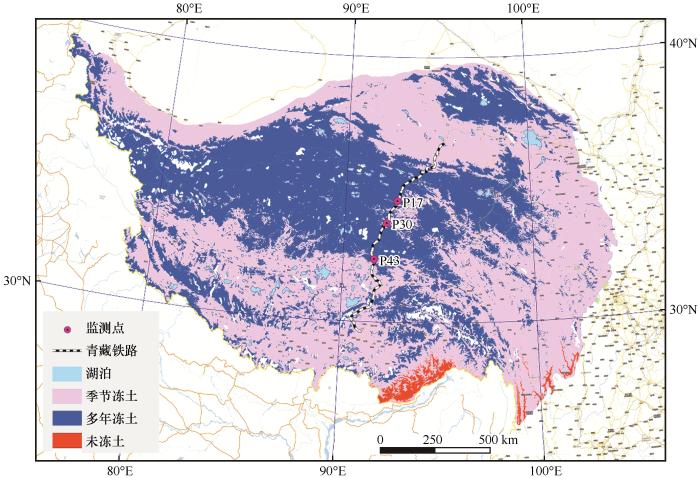
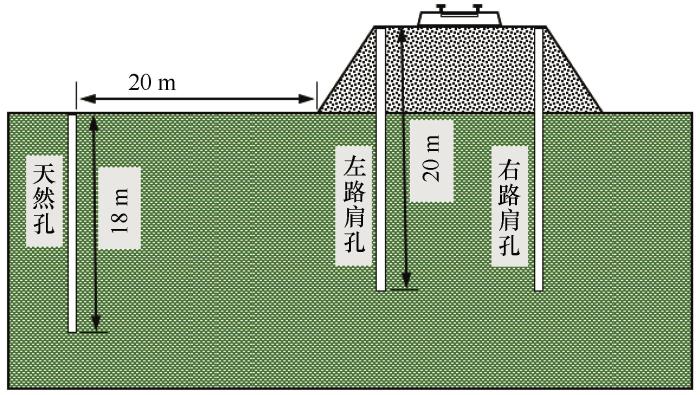
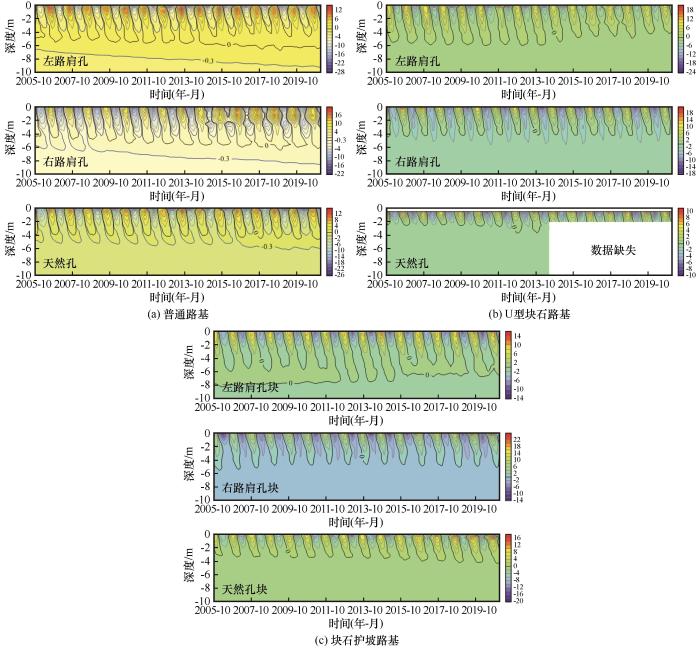
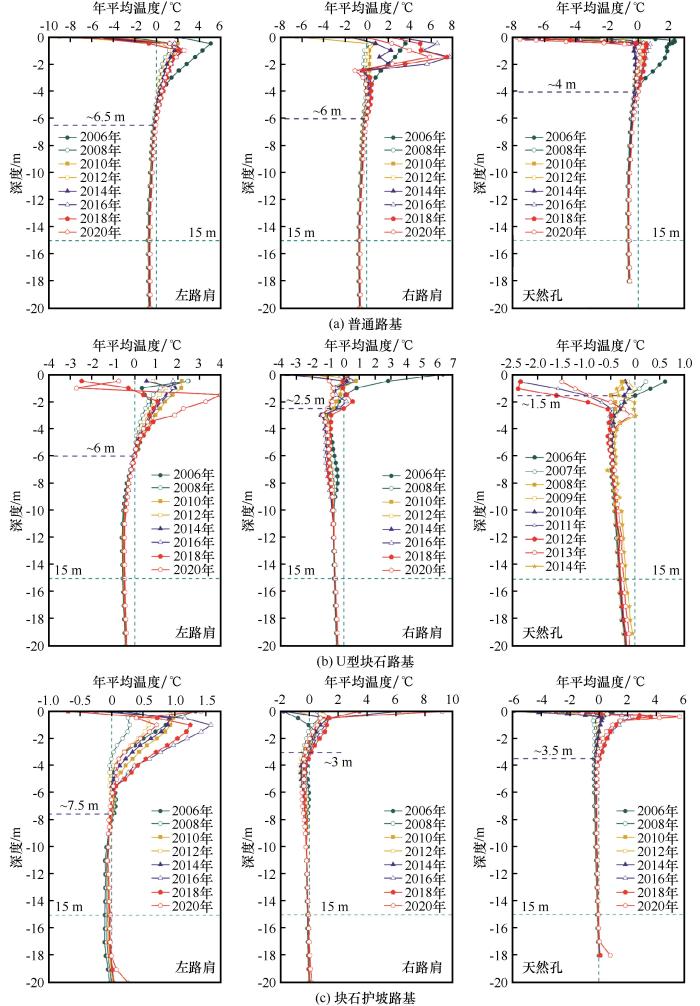
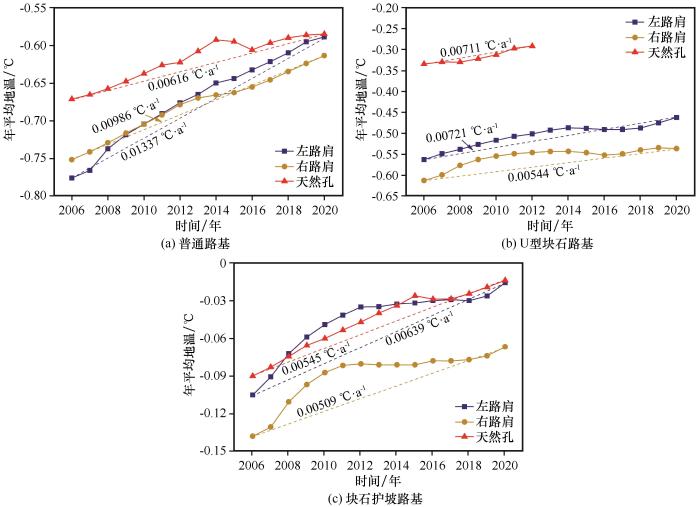
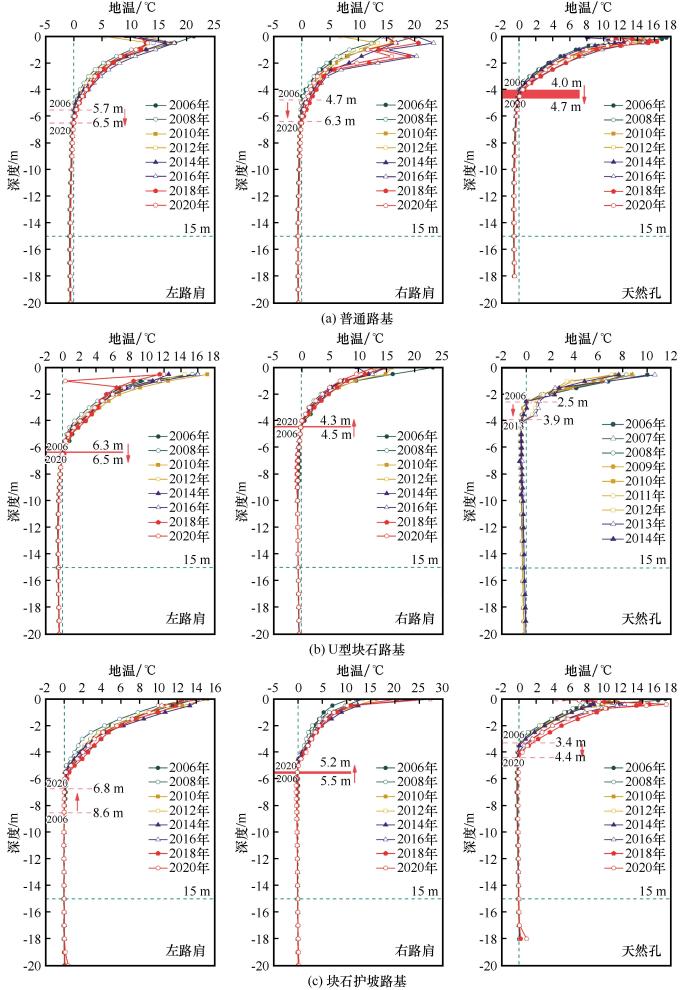

 甘公网安备 62010202000676号
甘公网安备 62010202000676号